WINTER 23/24
THE SKI ISSUE ADVENTURES ON













THE SLOPES
THE BEST SKIS & BOOTS NEW SEASON’S SKIWEAR ENTRY LEVEL GEAR
ULTIMATE ACCESSORIES
WILD RIDE:
SKI TOURING NORWAY
MOUNTAIN LEADERS:
6 ECO-CONSCIOUS RESORTS
KIRSTY MUIR:
FREESTYLE PHENOMENON
CRANS - MONTANA
Roger Moore’s former home has more recently gained the attention of discerning skiers looking for world class accommodation and facilities in a resort that has become one of Europe’s most vibrant and dynamic destinations.
Sitting on a high plateau above the Rhone Valley, the sweeping views from the ski resort of Crans-Montana offer some of the most spectacular panoramas in Europe.
From Mont Blanc to the Matterhorn, many of the big north facing peaks of the western Alps glitter in the cold winter sun.
Crans-Montana’s south facing slopes offer sunshine even during the early winter. But with a skiing area starting at 1500 metres and rising to 3000 meters, good snow conditions are expected here between December and April.
World-class ski runs such as the Mont Lachaux piste that hosts the women’s World Cup downhill race and the Kandahar, one of the longest black runs in the Alps, offer experienced skiers plenty of on-piste thrills. For beginners, one of Switzerland’s largest areas for learning to ski can be found on the slopes of the town’s world-class golf course, covered in a snowy blanket throughout the winter. For intermediates, there’s a huge choice of blue and red runs stretching across the entire ski area.
The resort has a large snow park, the largest marked ski touring park in the Alps, and one of Switzerland’s longest cable cars taking skiers up to the 3000-metre Plaine Morte Glacier.

Down in town, there’s no lack of action either. Serious shopping awaits and over 90 restaurants serving both Swiss and international cuisine offer the kind of choice normally only found in large towns and cities. The incredible sporting facilities such as the Alaïa Chalet, a huge indoor action sports centre, attract freestyle addicts all year round.
Crans-Montana is famous for its huge choice of hotels, with a number of 3, 4, and 5-star properties that include everything from cosy family run lodges to international brands like the Six Senses.
Travelling to Crans-Montana is easy, with a train connection from Geneva Airport that includes a short funicular ride directly into the resort itself – making the resort popular for short trips. Although most visitors decide to stay for just that little bit longer.

“South facing slopes offer sunshine even during the early winter”
Winter facts:
140km of piste
with 1500 metres of vertical
24 ski lifts
100,000 square
metre snowpark with one Olympic half pipe
15 marked ski touring trails

1 ice rink
87km of winter hiking
trails
2 World Cup ski pistes


90 restaurants and bars
180 boutiques and shops, 1 casino
300 events and festivals every year
Labelled a family resort by the Swiss Tourism Federation
New Ski & Snowboard Collection






EXPLORE WELCOME TO

For me, skiing has long been an obsession. I was fortunate to strap on skis from an early age and have loved it ever since. I’ve worked ski seasons (check out our article on p.22 for whether it’s still possible) and skied many of the eco-conscious ski resorts on p.38. But as I get older, the creeping doubt in my skiing ability can be a real obstacle to the pure joy of skiing. If you’re like me, then Louise Podes’ advice on p.61 will resonate and reassure.
Getting my first ski boots is a moment engrained in my memory, so I enjoyed a nostalgic dive into six decades of ski boot development (p.10), while our ski hardware highlights bring you up-to-date with some of the best in the range. We also reveal our most wanted outfits for the season, shot on location in Crans Montana – our winter resort partner (p.42).
If you still haven’t decided where to head this winter, see p.26 for inspiration, where our team experienced backcountry skiing at its finest in Arctic Norway with our friends at Pure Ski Touring. If piste is more your thing, let the Swiss locals guide you (p.54) with tips on the best places to ski, stay, and après in Valais while avoiding the Verbier crowds.
ellis-brigham.com



For more inspirational content and ideas follow us on Facebook and Instagram. We’d love to hear about your adventures, share them with us using the tag #ellisbrigham

06. DIARY: WHAT’S ON


You essential guide to this winter’s skiing events.

08. SPOTLIGHT: POW

The battle for the climate is entering a critical 12 months.
10. TECH TALK: SKI BOOTS
How skiing footwear went from cottage industry to space age.
14. KIRSTY MUIR
All hail Scotland’s new queen of freestyle skiing.
20. PARK LIFE
Skis and boots to take your slopestyle game to the next level.

22. WORK ABROAD
Post Brexit, we ask: can you still do a season?
26. SUMMIT TO SEA
An epic ski touring adventure in Norway’s Lyngen Alps.

34. EARN YOUR TURNS

Skis and boots that smash the climb as well as they descend.
36. FABULOUS FABRIC GORE-TEX and Patagonia join forces to improve sustainability.

38. ECO-CONSCIOUS RESORTS
Six mountain destinations minimising their carbon footprint.

42. FABULOUS SKI FASHION

Highlights from this season’s skiwear collections.
50. CARVE A PATH
I hope this ski issue of Explore will make you want to click in and head to the mountains. With snow already landing across Europe in September, we dare to dream of a legendary snow season! Proud




A selection of the finest pistefocused hardware on the market.
52. ALL ROUNDERS

Need ski gear that can tackle the whole mountain? Look no further.

54. FACES OF THE VALAIS




Locals from Switzerland’s best ski region reveal their top tips.

60. THE MENTAL GAME
How to conquer those skiing demons and enjoy your holiday.
63. HEAD START
Great value skiing kit to accelerate your progression.





64. ESSENTIAL EXTRAS
Amazing accessories to complete your winter wardrobe.
66. LOCAL KNOWLEDGE
Matt Brown from our Aviemore store shares his Highland highs.
IMPROVE YOUR SKIING CONFIDENCE
We’ve all had ski lessons and know how to ski – that’s not the problem. The challenge for anxious skiers is how to overcome the fear factor so that they can build their confidence and actually enjoy skiing. If your mindset is holding you back, and negative emotions like anxiety and fear overwhelm you on the slopes, then this evening is for you.
Join Rob from New Generation Ski School and Louise Pode, Executive Coach and NLP Master Practioner, for two exclusive evenings aimed at giving you the mental tools to flip the script and improve your skiing confidence.
And if you can’t make the events below, check out Louise’s tips on page 60.
Ellis Brigham, Covent Garden: 14 November
Ellis Brigham, Manchester: 15 November
DIARY
EVENTS
Ortovox O -Piste Awareness Tour (Ellis Brigham stores)
Covent Garden: 30/31 October
St Paul’s: 1/2 November
Manchester: 13/14 November
Braehead, Glasgow: 20/21 November
If you’re keen to venture into the wilds on your skis then it pays to be prepared for any situation. Learn the essentials of backcountry safety with the experts from Henry’s Avalanche Talks, in association with Ortovox.

Warren Miller’s ALL TIME
Nationwide: October 2023
warrenmiller.co.uk
Get ready to fuel your snowy dreams with Warren Miller’s ALL TIME. The legendary film crew’s 74th annual release takes us on a tour through the ages, from the birth of some of America’s iconic ski towns and the original hotdoggers to the most unforgettable talents and outlandish locations ever captured on camera.
Warren Smith Technique Lab Tour (Ellis Brigham stores)
Manchester: 10 October
Kensington: 24 October
The Warren Smith Technique Lab Tour is an opportunity for skiers to assess their current level in six key areas – from biomechanics and equipment to strength and stability – giving you a head start on the season before even setting foot on the slopes.
European Outdoor Film Tour (EOFT)
January 2024 Nationwide gb.eoft.eu
The EOFT is the largest outdoor film festival in Europe, featuring a collection of short films and documentaries that push the limits of extreme sports including skiing, mountaineering, mountain biking and kayaking. See website for full listings.
For more information, up-to-date listings and to book your place go to ellis-brigham.com/events
ALL DAY LONGER.
Meet the original stay-out-longer ski sock. Made with Smartwool’s perfect fit and naturally performing Merino wool to help keep your feet comfortable from first tracks to last chair and beyond.


VOTE FOR WINTER
Amidst all the excitement for the coming ski season, the climate debate continues to loom large. We sat down with Dan Yates from Protect Our Winters to discuss the critical next phase.

How has the climate debate evolved since last winter?
The most recent data says that we’ve now used 50% of our available carbon budget if we want to stand a [good] chance of meeting the 1.5 degrees warming set out at the Paris Agreement. In the last two years we’ve used half the carbon that we have left.
When’s that target deadline?
The idea is to reach net zero by 2050. But actually if we continue emitting as we are now and then stop emitting anything in 2049, we’re still going to miss that 1.5 degrees. The reason it feels so critical is that all of the decisions that are going to affect [the outcome] are going to be happening in the next political cycle.
What are the key events you’re looking at?
Our sights are firmly focused on the EU elections next June. The next parliament will have the final chance to make these [key] decisions. It’s the same with the UK – we’re probably looking at an election in autumn 2024, and the next government will really decide whether the UK is meeting any of its targets. And the US has got [its own] election next November as well. These elections are critical for us.
Do you tell people how to vote?
We will always be bipartisan in our outreach, so we’re always trying to reach out to politicians of all sides and make a positive request. But we’re going to release a POW white paper at the ISPO trade show in November [which will outline] what we expect from future MEPs that are being elected. Then we’ll be urging our community to go out and vote with that in mind. We’re not telling them who to vote for, but we’re telling them the policies that they should be voting for.
Aside from the political debate, how has the climate itself actually changed this year?
July 2023 was the hottest month ever recorded globally. This year has also seen the highest surface sea temperatures ever, and the lowest extent of sea ice. It has been an unprecedentedly
hot year, following on a trail of previously unprecedented hot years in [the past] decade. Fortunately we had quite a wet and snowy end of the season that helped the glaciers a little bit [in the spring], but the recent heat has undone that. Glaciers tend to be impacted less by how good the winter is, and more by how hot summer is. And we’ve been seeing not just glaciers retreating in the normal way, but quite significant collapses as well – the most famous one being the Marmolada in Italy last year, where literally a third of the glacier was lost.
What activities have you got coming up this winter?
We’re hosting the first ever ski hard goods climate summit in Salzburg this September. We’re going to have representatives from the manufacturers responsible for 75% of the skis and snowboards that are made in the world, and from the major material suppliers and retailers; around 120 delegates. We’ll be spending two days talking about how we move forward as an industry – not only reducing the climate impact of the production of ski equipment, but how we can be seen as a role model on climate action as opposed to part of the problem. We need to remove the competitive nature from the sustainability argument among these companies and move it towards a collaborative approach.
Is that competitive element never a positive thing, if people are fighting to be greener than the next brand?
I think it leads to accelerated claims which are not necessarily always there. And you’re always going to do better collaboratively than you are individually, particularly when it comes to things like purchasing good materials. We see that in the textile industry already. For instance, Smartwool and Icebreaker have moved over to collaborative purchasing of merino wool because it allows them to support these regenerative agricultural farms.
What else is happening?
We’ve got our educational programmes that we run. By the end of the year, we’ll have trained facilitators to deliver athlete training across much of Europe. And we’re rolling out our Hot
Planet Cool Athlete programme, where an outdoor sports athlete – a climber, skier, snowboarder or mountain biker –visits schools alongside a power educator. There’s one for 11 to 14-year-olds and one for 14 to 16-year-olds. They learn all about basic climate science, what they can do to advocate and how they can become the advocates of the future.



How can the reader of this magazine get involved with POW?
Every POW chapter has its own channel that people can follow. We’re in 10 different countries across Europe; each chapter has its own newsletter and Instagram. You can get in touch and find a way to volunteer, or send donations to support the work that they’re doing. You can also talk to your company about partnering with POW in the business. But as I say, with these elections coming up, the most important thing that you can do is vote. Use your voice.
“The most important thing that you can do is vote. Use your voice.”Above Glacial retreat continued at a record pace in 2023. Below Many ski resorts face an uncertain future.
BEST FOOT FORWARD TECH




Few items of footwear have evolved as dramatically as the ski boot. From leather to space age composites in under 50 years, Ski Equipment Buyer Steve Wells Creative Director Dave Whitlow talk us through its rapid transformation.






When did Ellis Brigham start selling ski boots?
There wasn't much of a commercial ski boot market until the 1960s. Prior to that, skiing was primarily an aristocratic or military activity. You went to your ski boot cobbler in Gstaad or wherever; it was more of a cottage industry. But as air travel started to be more affordable and ski holidays became more of a thing, the market stepped up. The first boots we sold were basic leather and lace-up affairs from brands like Koflach and Caber.
How did they work?
and


















The bindings weren't releasable in those days, so you just literally slotted your leather ski boot into a metal and leather strapping type system. It was a development of Nordic equipment which had been around in Scandinavia for quite a while.








And how did they begin to evolve?
The laces went and you started to get leather boots with clips, which stiffened them up. Then they started to laminate or stitch plastic to the outside. Bob Lange – the founder of Lange boots – was the first to crack this. They weren't the two-piece ski boots as we know them now; that came later.
What were the disadvantages of those old boots?
It was difficult to steer your skis with floppy leather boots. And they also got wet, no matter how much you looked after them and waxed them. The beauty of leather is that it softens with age, but in this case the more comfortable they got, the less able they were to drive your skis.
So what came next?
The bindings weren't releasable in those days, so you just literally had plastic outer shells and a separate leather-and-foam liner.




The next evolution was separating the inner and the outer, so you had plastic outer shells and a separate leather-and-foam liner. That meant they could use very hard plastics and take the levels of stiffness and control even higher. This was in the 1970s, and to all intents and purposes the concept has not changed a great deal since then.

TECHNOLOGY

“THE BIG TECHNOLOGY THAT'S HITTING THE SHELVES THIS SEASON IS BOA”


































They must have looked incredibly futuristic at the time – like something out of Star Wars! They really did. And the 1970s [fashion] played into that as well. You know, ski wear was very ‘out there, man’. There was a flood of crazy one-piece ski suits along with these space-aged ski boots.
And then rear-entry boots became all the rage for a while,

didn't they?
Yes. The downside of plastic ski boots was they were very difficult to walk in, and quite difficult to get in and out of. In around 1977/78 Brigham’s got some Scott and Hanson boots in; these were the first rear entries. It was a development from America that looked even more space age. The Hansons had wax in the inner that moulded to the foot after you warmed it up, and they were super, super tight to the leg. It was a really funky look! The Scott had large elements of fibreglass in the outer, which was very stiff, but both of those boots
the leg. It was a really funky look! The Scott had large elements of were rear entry.
Salomon's new S Pro Supra is one of the new wave of BOA ski boots.


The ones people will remember were made by Salomon, right?
The ones people will remember were made by Salomon, right? Well, Scott had quality issues because unfortunately the fibreglass cracked, and Hanson just literally ran out of money. But Salomon had seen these innovations, and they were very good at making innovations mass market. So that's what they did. They made sure everything was absolutely bang on, and in 1979 they launched the SX-90 boot. It was a huge success, and lots of different ski boot companies followed suit. Every rental shop around the world suddenly wanted rear entries because they were just a dream; they didn't hurt people's feet.
Who else is worth a mention here?
The Italian brand Nordica went to some bizarre lengths with rear entry design. They even had a knee-high model called the Polaris. It was supposed to accentuate the leverage over your skis and give you massive drive. They were short lived, but they were hilarious!

Where did the rear entry dream go wrong then?
I think the racers never felt like they had the control that a four-clip boot was giving them. A four-clip is going to wrap around the foot and hold it better. The spine is also stiffer so they could put more power through the ski. Naturally, if the top athletes and instructors –you know, the influencers of their day – are using four-clip boots then people are going to want a piece of that.

Is this where we start talking about overlap versus cabrio?

Well, a ski boot is about how the liner fits you and how the shell fits you. And with the rear entry boot being one piece over the foot, you're not






FOR BETTER FIT WITH REDUCED PRESSURE POINTS
changing the shape of the plastic. You can adjust the liner but that’s it. That's where the cabrio design [with a third tongue piece incorporated into the outer] starts to put a little bit of pressure on rear entry because you're going to get a bit more comfort and control. Raichle were doing quite well on the World Cup circuit in the 80s, and their Flexon model became quite a cult boot. It had a corrugated tongue which was copied from the arms of a spacesuit. In the end though, different types of plastic that weren't so rigid came to market, and four-clip [overlap] boots became more of an option for your average consumer.
So the cabrio design died too?
Dalbello have remained committed to cabrio and K2 actually bought the factory moulds from Raichle, because a lot of freestyle skiers still want that kind of flex. They renamed it Full Tilt. But yes, the cabrio concept became a bit of an outlier.

How did things progress as we hit the millennium?
Through all this time we can't really ignore the liners; they are getting more and more comfortable. There are a lot more stitched elements and they're now heat-mouldable. Then in 2008 Salomon came out with a customisable shell which used a softer plastic in two specific points around the metatarsals. Again, the shop will put it on a heater, and it will mould to the shape of your foot. In reality there was a limit to how much it could be adjusted, but it really caught everybody's attention.
Where have things been evolving recently?
The hybrid market is now massive – these are boots that can do a little bit of touring. And the focus since about 2010 has been more anatomical design. 20 years ago, if you took a boot and flipped it upside down, it's pretty much an oval shape. But if you take a boot from 2020,
it actually looks somewhat like a foot. There are restrictions to how far you can go because of how it has to integrate into a binding, but the fit is much more dialled in. And then there’s GripWalk, which adds a very slight rocker on the toe to allow the foot to roll a bit more when you’re walking. You know how every snowboarder loves to watch the skiers carry their chips and Coke across the wooden decking at lunchtime? GripWalk ruins that sport a little bit! It sounds like a really simple thing, but all the bindings have had to have a redesign because it changes the height of the ski boot slightly.
So what’s the very latest tech buzz?
The big one that's hitting the shelves this season is BOA. BOA lacing has been seen on soft footwear for ages, and some ski boots have used it on inners, but what they’ve done now is incorporate it into the forefoot of the shell using five tension points. The cable is ridiculously strong, and as you tighten the one dial, you're pulling across five separate points, whereas before you were pulling on just two clips. So it improves the fit because it wraps more. The big thing that the industry and customers have to get round is that it looks weird; it’s not what they’re used to.
Technology never stays still though, does it?
It doesn’t. In fact it’s funny how it can evolve and come back around. For instance, rear entries are back – and in quite a big way. Three years ago Nordica launched a boot called the HF – ‘HF’ stands for ‘Hands Free’. You unclip it, open it out and just pop your foot in it; then it's just one lever at the back to do it up and away you go. As soon as we put it into the shops, we got loads of people walking in. There are so many skiers out there for whom pure performance is not the priority.
Is there a holy grail?
What all the brands are still working on is how to customise a boot to someone's foot as easily as possible, whether it's the liner or shell. We've probably reached about as light as we can get. Now it's about making it comfortable without losing any performance.
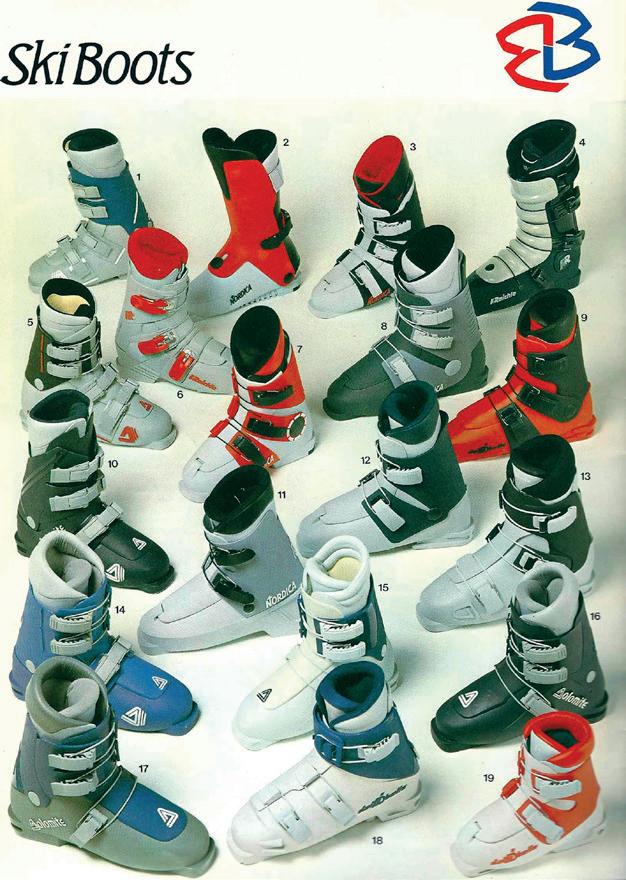
“REAR ENTRIES ARE BACK –AND IN QUITE A BIG WAY”
Heat-mouldable liners were a total game-changer.

HEATMOULDABLE FOAM LINER ENABLES A CUSTOM FIT

































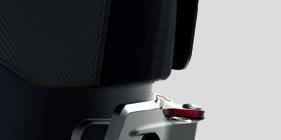








ANATOMICAL SHELL WRAPS THE FOOT TO IMPROVE COMFORT



FREESTYLE

EYE OF THE STORM

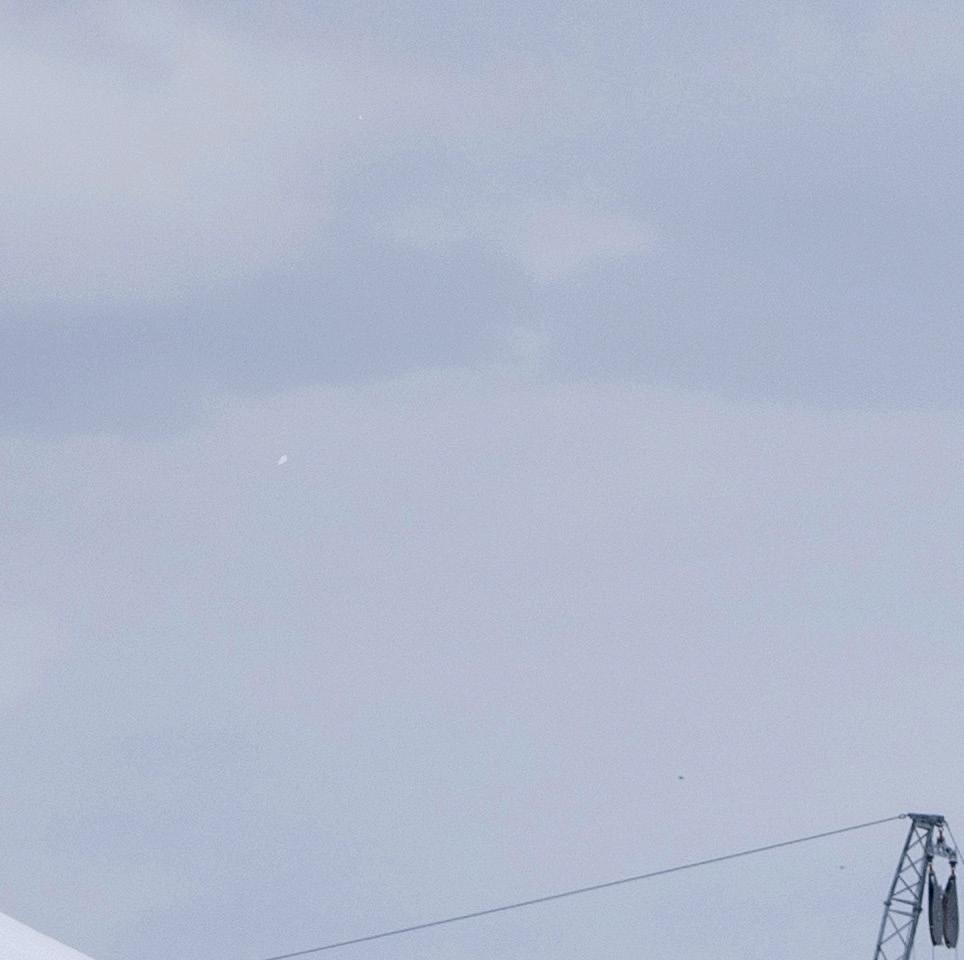

From Aberdeen’s dry slope to an Olympic final, 19-year-old Kirsty Muir has flown straight to the top of freestyle skiing.








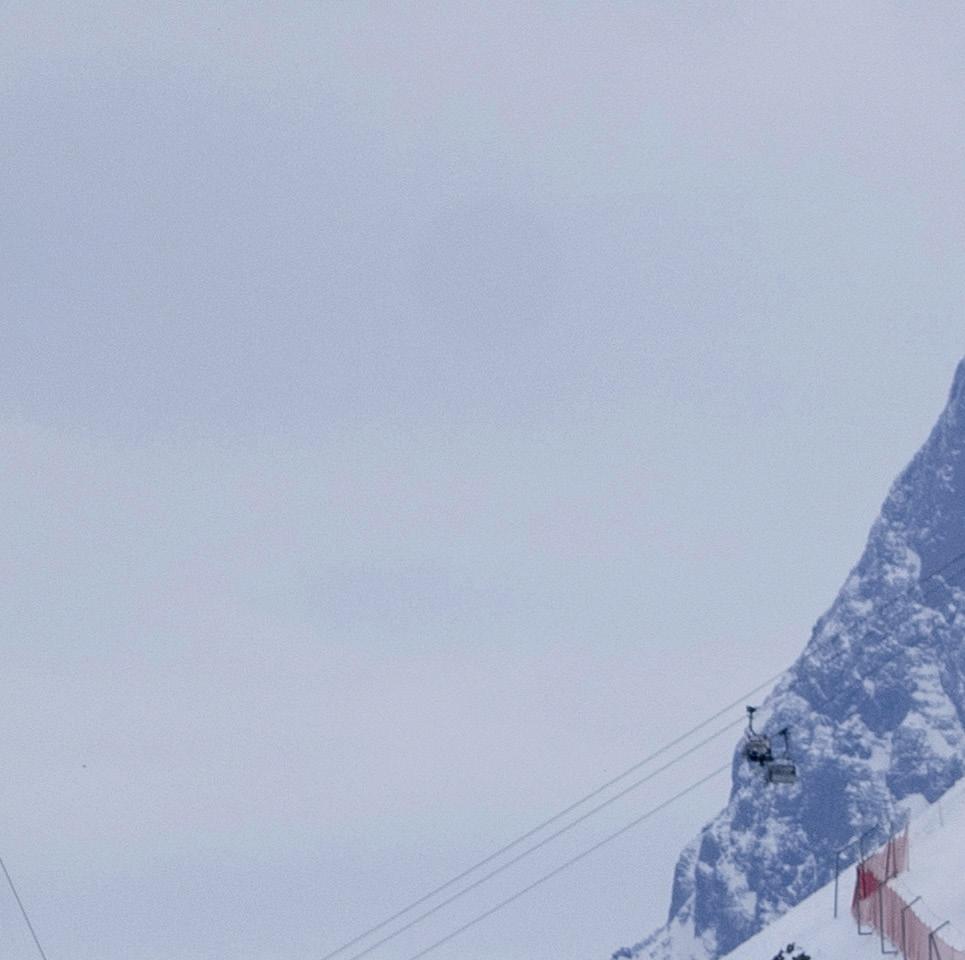


Interview Andrew Duthie Photos Red Bull Content Pool

Picture the scene: a pigtailed teenager is swept up from her regular life, and finds herself dropped from on high into an exciting world full of colourful characters and amazing feats. She does things she never thought possible, and audiences are spellbound.
Sound familiar? It might, given that it’s the story of Dorothy in The Wizard of Oz. It’s certainly not the story of Ellis Brigham Freeski Athlete Kirsty Muir, whose route to the pinnacle of the only slightly less fantastical realm of freestyle skiing came with no shortcuts. There have been no cyclones, other than those of her own making as she spins her way to success on some of the sport’s biggest stages. No, hers is a story of passion, dedication, putting in the hours and rising through the ranks.




“I don’t feel like there was a turning point, or anything,” she explains from her family home near Aberdeen. With easy access to a freestyle-friendly
dry slope, as well as the Lecht and Glenshee when real snow is around, there are worse places from which to embark on a snowsports career. Coaches at Aberdeen Snowsports Centre’s junior sessions soon spotted her talent – and, crucially, how much she was enjoying getting airborne. “I just had so much fun and progressed, and started doing competitions around the UK – it gradually built from there.”
And build it did; in 2018, 13-year-old Kirsty swept the board in the senior categories at the British Championships, winning the Big Air, slopestyle and halfpipe titles. Two years later she took silver in the Big Air – as well as fourth place in the slopestyle – at the Youth Winter Olympics. By 15, she was being referred to as one of the brightest prospects in skiing. Then, just a few weeks later, she wasn’t able to leave the house.





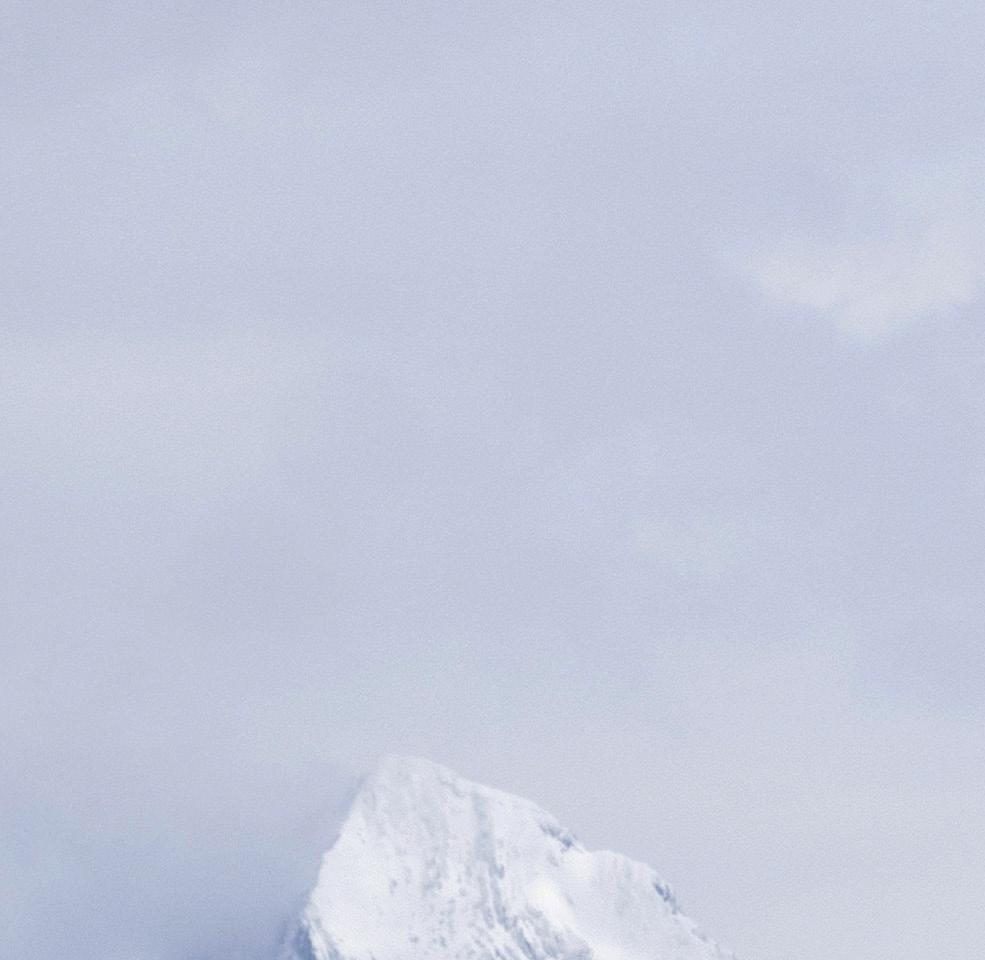
ADDIKT PRO
(Get) addicted to (making) the right turns in life.
Combined with the ski’s Woodcore and double TI construction, it takes your speed to the limit of your comfort zone whenever you choose to.

It increases the flexibility of the tail by 5% for a more forgiving yet responsive all-day ski.

Made to get a super agile and playful ski, so you can mix short and long turns, at high or low speed, and fully enjoy your day on-piste.

The COVID-19 lockdowns were, by their nature, disruptive, and countless studies have been conducted on what particular effect that has had on the young. What must it have been like for someone like Kirsty, who had just seen a door open only for it to be immediately slammed shut? “That was pretty crazy,” she remembers – but is quick to point out the upside. “I was studying for my first exams, so it was quite good for me in the schoolwork sense, because I hadn’t done that much during the season!”
In a way, the transition period between promising junior and fully-fledged elite skier was actually quite a good time for the lockdown to happen. “I hadn’t fully started World Cups or anything by then. So I hadn’t really broken into the scene, I hadn’t met many people, hadn’t made the friends that I have now from the circuit. So at the time it was more just missing skiing, but I felt it wasn’t too bad. I think I was pretty chill with it, riding it out.”
So calm is her demeanour that it’s hard to think what it’d take to actually get her rattled. A talking lion?
Flying monkeys? In any case, that attitude will come in handy now, with plans to hone new tricks on the airbags of Europe on hold as she recovers from a nose operation and rests a niggling hip injury. Both affected the tail end of her 2022/23 season, but not before she’d reached a new career high, scooping up bronze medals in both of her events at the X Games.
While it would appear that the sky’s the limit, there are no specific results or achievements on her to-do list. “Mostly I go with the flow. Obviously I have personal goals – to just keep improving my tricks, and I just want to keep doing as well as I can in the competitions, keep getting on the podium, or just landing the best runs I can. I like keeping my goals open and just enjoy myself, and try to push myself.”
That focus on self-improvement even helped to take any potential sting out of narrowly missing out on an Olympic medal in 2022, where she qualified for both Slopestyle and Big Air finals and earned fifth place in the latter. “That was, at the time, the best that I could ski, and I was really proud of myself,” she says, recalling the Big Air final. “I landed my [tricks] the best I have done. Even to this day, they could still be classed as my best ones, you know?”

Even as her focus appears to be squarely on her own performance, her fellow competitors are providing no shortage of motivation. Canada’s Megan Oldham has ushered in a new era in women’s skiing, having landed the first triple-cork (a complex move involving three offaxis rotations) in competition at this year’s X Games. We might not see it in Kirsty’s trick bag just yet (“I’ve got a lot more to work on before going for that!”) but there’s no denying that it’s an exciting time to be a pro.

“I LIKE KEEPING MY GOALS OPEN AND JUST ENJOY MYSELF”
That being said, after spending years juggling studies with skiing – often taking her textbooks on flights around the world – she hasn’t ruled out taking that side of her life to the next level either. “I’ve not got a plan right now for university, but I would definitely love to at some point, whether that’s online [or at a campus]…. I particularly enjoyed biology and maths [at school]. I’m not really sure what I want to go into, but something maybe to do with them. I would probably have got into studying straight away if I really knew I wanted to study. But I’m not really sure at the moment. I’ve had one gap year – and I’m taking another one, it seems!”
For now, surely the draw to stay on the circuit must be irresistible, especially given her ever-increasing levels of success? Is there not some part of her that wants to let the books gather dust and go all-in on competing? “I feel like my brain’s kind of saying that already!” she laughs. “I’m really enjoying it. If something pops up [in education] that I’d enjoy, I’d consider it, but for now I’m just going skiing…”
It’s hard to take issue with that, given how Kirsty seems to love her sport like the Scarecrow loves chatting to plants. She’s grateful for the support she receives, and credits GB Snowsport coaches like Joe Tyler (“I’ve known him for so long and he knows me really well – he knows exactly what to say”) with helping her raise her game; still, there’s no substitute for self-motivation, and she’s got it in spades. While medals and podiums are there for the taking, they come across as a secondary concern.
Take, for example, the way she recounts the disruption caused by her recent nasal troubles. Even when forced to withdraw from the World Championships slopestyle, what was more consequential for her was that “I really wanted to push through, and try and do my best – [but] I wasn’t able to ski at my fullest, which really made me… it just made me a bit sad, you know? You just want to be able to ski as best as you can, and really have fun with it.”
All being well, by the time this is published Kirsty will be on European glaciers, back on track and preparing for an exciting winter season in which another
X Games invite is surely a formality. She’s also hoping for a return to Jesper Tjäder’s ‘Unrailistic’ event, and an improvement on her injury-affected performance at the previous edition (in which she still took home the Best Trick prize). As for Olympic preparation, ask her again in a couple of seasons: “I’m definitely excited for the next one, but I’m kind of putting it to the side as well, because it’s so many years away.”

Another competition she’s hoping to be back at this winter is the British Championships. After being based for several years in the Swiss freestyle mecca that is Laax, in 2023 the event returned to its roots in Scotland, and Kirsty was one of many to be happy about the move. “I think it was super nice to have it on the home mountains. Obviously it wasn’t as big


a setup as I’d like, but at the same time, I think it’s really great to have it in the UK because we can bring a lot more people. Some people just cannot get out to Switzerland for the competition, so I think having it more accessible is really good for the generation coming through.”
It’s not just about the contest, of course; as the highest-profile event to be held in the Scottish mountains for years, it provided a much-needed focal point for the UK snowsports community. “There were a few people that I haven’t seen in years, since I was super tiny… I just think it was really good to bring the community back together.”
Even as she’s set to conquer the skiing world, it seems there’s no place like home.

“YOU JUST WANT TO BE ABLE TO SKI AS BEST AS YOU CAN AND HAVE FUN WITH IT”
PARK LIFE
FREESTYLE SKI GEAR
























LINE MEN’S CHRONIC 101 £490



All new for 2024, the Chronic 101 is a versatile all-mountain freestyle ski that has durability literally baked into its core via bio-resin technology. This innovative and environmentally-conscious resin offers a stronger bond in cold temperatures as well as substantially reducing the carbon footprint of each ski. A 30% thicker base and edge beefs things up even further.





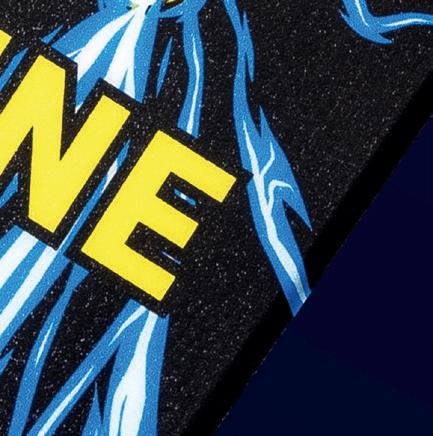









ATOMIC MEN’S BENT 90


£440















The Bent 90 is a true allterrain workhorse, taking on anything from jumps, rails, and pipes in the park to hardpacked piste and fresh snow. The narrow 90mm waist lends it a nimble, responsive ride, while the Light Woodcore keeps weight down but maintains stability and shock absorption front and centre.





ARMADA WOMEN’S ARW 88




















£500


Ticking all the boxes for a women’s freestyle ski, the ARW 88 is packed with tools for the job. A snappy poplar core, 88mm waist and shorter turn radius in the centre of the ski increases carving control, while the w3Dgewall construction and durable S7 base – coupled with 2.5mm heat-treated edges –mean durability isn’t an issue.










K2 FL3X MEN’S REVOLVE PRO £400
















The K2 FL3X Revolve Pro ski boot delivers performance and comfort in spades thanks to the smooth-flexing 3-piece design, moderate 100 flex, heat-mouldable Revolve Shell and an Intuition Pro Wrap liner. The tongue can also be swapped for different flexes so it’s perfectly at home in the park or in full freeride mode.








K2 FL3X MEN’S METHOD PRO GW




£400
If you’re seeking all mountain performance combined with comfort, you’re in the right place. Using the roomier K2 Method shell (102mm forefoot) for extra wiggle room and the heat-mouldable Intuition Wrap liners, a comfy fit is assured whatever your day holds. The K2 3-piece design and Shock Absorber Boot Board soak up the bumps.



K2 FL3X WOMEN’S REVOLVE



£350

A progression-friendly boot both in the air and on the slopes, the women’s specific Revolve will deal with anything you throw at it. The shell offers precision and support and is fully heat-mouldable, while the Intuition Tongue liner’s laminate design delivers excellent comfort. Its Grilamid tongue boasts an impressive strength to weight ratio to amp up performance.






CAN YOU STILL DO A SKI SEASON?

Post-Brexit, finding seasonal work in the Alps can be a challenge. Sam Haddad looks at the options.
Whether it involves washing dishes, pouring shots, serving up elaborate chalet meals, or driving guests along the Autoroute Blanche from Geneva airport and back, working a ski or snowboard season in the Alps has long been a rite of passage for thousands of young British people.
For most of them, it becomes a life-defining experience, kickstarting or cementing an obsessive love of skiing and snowboarding they most likely still harbour today. New friendships are forged – not to mention a level of inner confidence you can only get from living in another country for the first time in your late teens or twenties.

Despite the stereotypes of seasons being mostly about having fun on the mountain and getting drunk in sweaty bars, they are also incredibly helpful career-wise. You get to practise a foreign language regularly and learn invaluable business and customer service skills, says Iain Martin of the Ski Podcast, who founded a recruitment website for ski season workers in 1999.
“Many people working in the industry today honed those skills doing seasons, and subsequently went on to set up businesses that have been successful,” he says. This is backed up by research from the trade organisation, Seasonal Businesses in Travel (SBIT), which found that 49% of industry leaders started their careers with an overseas season, be that as a chalet host, ski guide or travel rep. And people who do seasons will often be ski and snowboard trip regulars for life, having an outsized economic impact on the snow travel industry moving forward.

But Brexit has undeniably thrown a spanner in the works –at least in the short term. When we left the European Union on 31st January 2020, one of the things we forfeited was our right to work in Europe and stay beyond 90 days. According to data from SBIT, before the 2016 referendum around 25,000 British people did seasonal work in France – a huge chunk of those in ski resorts. And those figures are likely to be even higher as they don’t include informal work.
Today, ski businesses in the Alps look to find workers with EU passports – be that Irish citizens, British people with dual citizenship, or Swedish, Danish, or Dutch workers (as they speak fluent English and understand the ski market).


YOUR PASSPORT TO THE SNOW
So, if you only have a UK passport and want to do a season, what are your options?
Ridiculous as it may seem, working further afield in Canada or Japan – where the visa process is more established and the ratio of jobs to applicants more favourable – could be the answer. A company such as BUNAC will, for £649, organise your working visa as well as subsidised staff housing and a pre-arranged 4-to-6-month ski season job in such powder meccas as British Columbia or Alberta. Or for Japan, the cost is £950 for a 3-to-4-month ski season job in Niseko, Rusutsu or Furano, with subsidised or included accommodation, plus three days of supported hostel lodging in Tokyo to get you settled in and minimise the culture shock.
British people can still find work in the Alps, but it varies from country to country, and cross-border work – such as being a transfer driver in France that picks passengers up from Geneva in Switzerland – doesn’t appear to be currently possible. Working in Austria and Italy is not easy – a quick browse on Interski for resort jobs in Italy shows only positions for EU passport holders – but there is a system in France, which is now online and easier for ski companies to navigate. Here’s how that works:
Ski businesses in France need to advertise a job for a certain amount of time, then if no suitable French or EU candidates apply (some firms are getting around this by advertising jobs that require native English speakers), they can open it up to British workers. The company then needs to secure the employee a work visa and employ them on their official French payroll (which is more expensive than British payroll). It’s a significant set of hurdles to jump through, and one of the reasons why chalets – and therefore chalet holidays – have been largely phased out by the big tour operators, though luxury high end offerings have been less affected as they can absorb the extra costs.
Seeking informal work under your own steam, as opposed to through an agency – be that babysitting, cleaning, DJing or being a handyperson (jobs which have sustained many a seasonnaire over the years) – is no longer possible, as you
need an employer to process your essential visa. Failing to have the right paperwork, the SBIT warns, could see you in “deep water and possibly even banned from entering any EU country in the future”.
Aside from the all-essential visa, the advantage of securing work through a ski operator is that it will often include accommodation, which is getting increasingly hard to find in the more popular Alpine ski resorts due to the rise of second home ownership and Airbnb.
There is some hope that the British government will reach an agreement with the EU that allows young people the right to work in Europe again, and the SBIT are lobbying for this to happen through an extension to the existing Youth Mobility Scheme, which already grants 18-to-35-year-olds from Australia, New Zealand, Iceland and (perhaps less obviously) Monaco and San Marino, the right to work in the UK.
But until then, if you want to head to the Alps, your best bet is to work in France through an established ski operator. Don’t be put off by the extra admin – once you’re carving beautiful lines in fresh snow with a bunch of new friends and generally having the best time of your life, you won’t even remember the hoops you had to jump through to get there.
For many Brits, it’s now easier to do a season in Japan than France.
DOING A SEASON OUR TOP TIPS
1. Consider ski resorts that are further afield, such as those in Canada or Japan, where getting a working visa may be more straightforward.

2. In Europe, France is the best option for UK workers. However, you will need to secure a visa via your prospective employer.
3. Seek employment directly through ski businesses. Do this as early as possible before the season starts.


4. Lobby your MP to make it easier for young British people to do seasonal work in Europe. It is an experience that can set them up for life.
5. Do it! You won’t regret it!!
“British people can still find work in the Alps, but it varies from country to country”
SUMMIT

AN ARCTIC SKI TOURING ADVENTURE



Arctic Norway has become a hotspot for ski touring in recent years. Tristan Kennedy and a team from Ellis Brigham travelled north in search of solitude.






TO SEA

As the van pulls round the corner, first one, then two, then the entire crew of us whip out our phones and start filming. Ahead, a row of jagged, saw-tooth mountains has risen up seemingly out of nowhere, as if someone’s just slapped on a fake Zoom backdrop behind the rolling hills we’ve been driving through. Behind the wheel, our Swedish guide Oscar Wahlund smiles, amused by the flurry of cameras. “Yes, that’s Lyngen,” he says, “they’re the steepest and highest mountains in this part of Norway.”
The precise mechanics of the ancient accident of geology that made these mountains so different to their neighbours remains a source of speculation as we drive onto a ferry and set off across the fjord towards


them. But for many years, according to Oscar, it made little difference to the area. Norwegian locals fished these waters like they would any other. Occasionally people scaled the peaks in summer, but Lyngen wasn’t a big tourist destination.



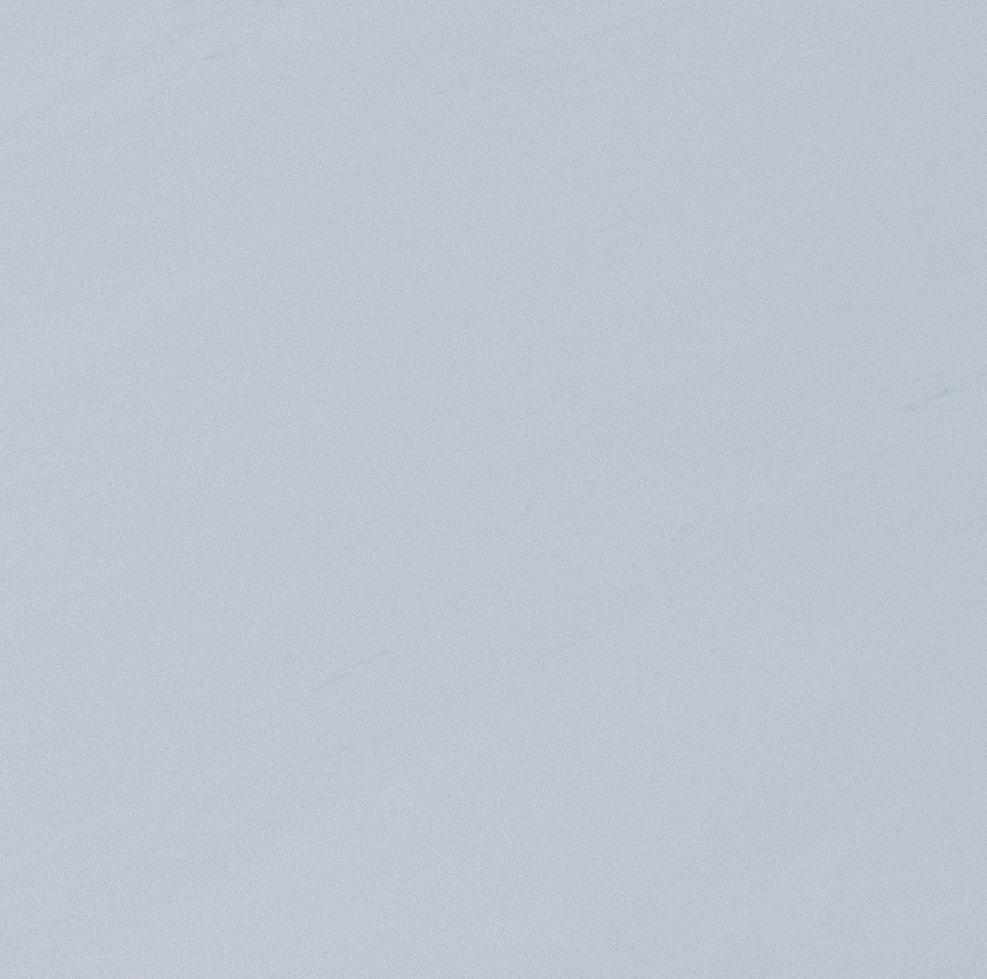



All that has changed over the past decade and a half, with the explosion in popularity of ski touring. “Guides from the Alps realised they could extend their season by bringing clients up here,” Oscar says. “There’s snow on the ground into May and even June. There are lots of glaciers, and there’s great touring terrain.” We’re visiting in mid-February on a tailored, long-weekend trip organised by Pure Ski Touring, a company run by Oscar’s fellow Swede Camilla Antonsson. The timing
 Photos Ross Woodhall
Photos Ross Woodhall




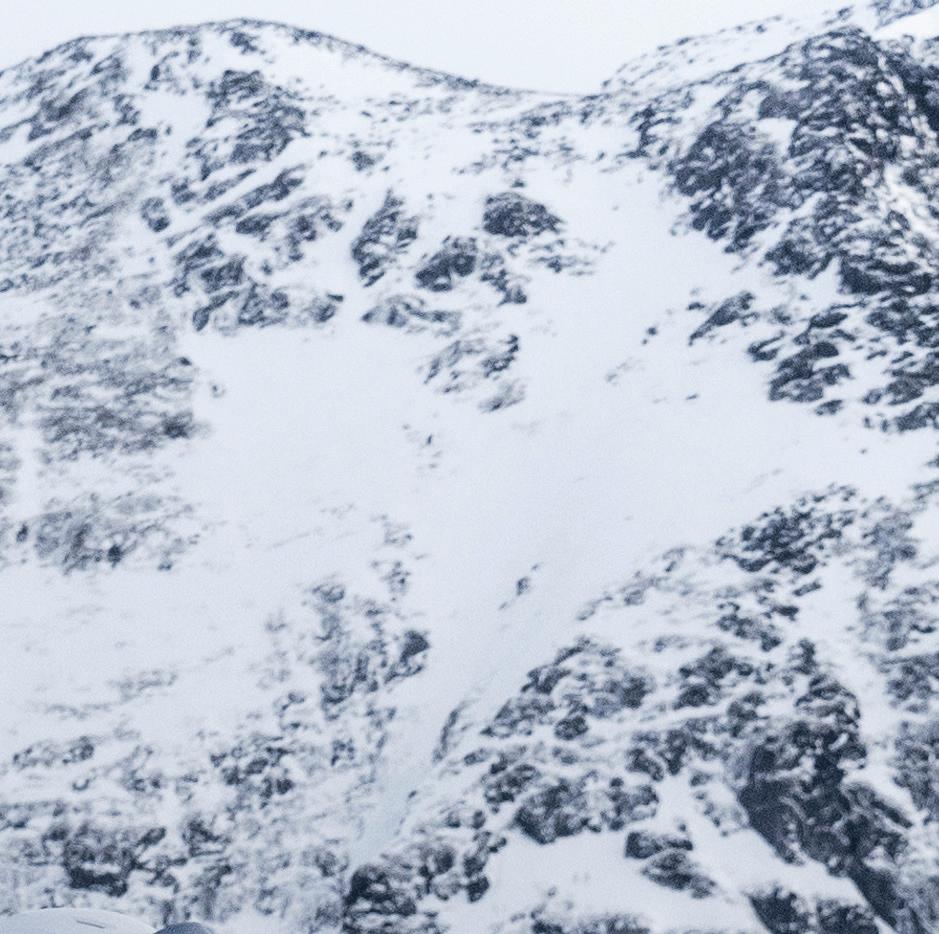







means that we’ll miss the touring-friendly 24 hours of daylight that you would get north of the Arctic Circle in May. But we’ll also miss the crowds. “In a few month’s time, there will be about one thousand more people here,” Oscar says. “See all these lodges along the seashore? 20 years ago, they didn’t exist.”
Our accommodation, the Magic Mountain Lodge in Lyngseidet, which opened in a refurbished hostel building in 2011, is a case in point. Run by a Finnish-Swedish couple, Henrika and Patrick, with the enthusiastic ‘assistance’ of their two young children, it caters for mountain bikers in the summer and ski tourers in winter, with hearty food, good beer, and a warm welcome.
For all the area’s recent popularity as an adventure destination, Lyngseidet has not lost its small-town, Scandinavian vibe. After dinner, I don my down jacket and walk to the petrol station to pick up dried fruit and snacks



for the following day’s tour. “Make sure you check out the Elektro Sport shop,” says Oscar. “It’s like an everything store for the community – I think it’s the only place in the world where you can buy ski touring equipment, and also a new washing machine at the same time.”

DAWN PATROL

We’re not up stupidly early the following morning –the sun doesn’t rise until just after eight – but ours is still the only car parked at the trailhead beneath Kavringtinden, the 1200m-high peak that’s our first day’s objective. In fact, aside from two local retirees, who’ve come for their morning constitutional on touring skis, we don’t see another soul all day.

As a guide, Oscar takes security reassuringly seriously. Despite our years of collective backcountry experience, he walks us through the basics of avalanche searches before we head on up the mountain, and makes sure we’re each equipped with an airbag, as well as our transceivers, shovels and probes. One of the things he likes about guiding in this part of the world, he explains as we climb, is that Norwegian rescue services are second to none. “They have all that oil money saved up, and that trickles down to everything, including the best helicopters and pilots. They even built their own avalanche warning app, called Varsom, from scratch – all free, and funded by the government.” Still, we’re taking no chances.
The hillside we’re climbing up is wild, open, and empty. We might be just above sea level – looking down over Lyngseidet’s picturesque harbour – but we’re so far north that there are no trees after the first hundred or so vertical metres. As with the upper reaches of the

“ASIDE FROM TWO LOCAL RETIREES, WE DON’T SEE ANOTHER SOUL ALL DAY”
Experience Exclusive Ski Touring Trips Led by Certified IFMGA Mountain Guides



We arrange world-class adventures, visiting the best mountain regions worldwide. Each trip is unique, with only one per destination per year.
Specializing in the Swedish and Norwegian mountains, we offer the unique experience of skiing under the Northern Lights and Midnight Sun.

Scottish Highlands, there’s little protection from the elements up here. Having consulted the Norwegian weather app Yr (another brilliant piece of governmentsubsidised tech) we know there’s snow due in the early afternoon. Unfortunately, it arrives right on cue. The wind gets up, the visibility closes in, and we’re forced to ski down before reaching the summit. But we still manage to make the most of the drifts where the snow has blown deeper, throwing up spray as we go.
WHERE THE MOUNTAINS MEET THE SEA
Our second and third days will be spent in Senja, a craggy island (now connected by a single, spindly bridge) off the west coast. “If you look at it on the map, it looks like a hand, with these long fingers, divided by fjords, reaching out into the Atlantic,” says Oscar.
One of the advantages of ski touring in this part of the world is that, although they’re snow-sure because of the extreme latitude, when it comes to altitude, none of the peaks are particularly high – at least not by alpine standards. Start from just a hundred-or-so metres above sea level and you can be at the top, ready to rip your first turns back down, within a couple of hours. With most of the crew occupied by shooting on day two, Oscar and I make the quick skin up to a ridge, from where I can see exactly what he means about the island’s geography.
To our right is a vertigo-inducing drop. To our left is the kind of wide open snow-field you’d have to climb above 2,500m to find in France, Austria, or Switzerland. And ahead of us, the summit ridge leads the eye out along a finger-thin sliver of land, towards the empty ocean beyond. The sun, which never rises much above 45 degrees in February, is sinking low in the sky, making the sea sparkle, and painting the snow a rich golden colour. It’s a landscape unlike anything I’ve seen on a pair of skis before – or off them, for that matter.
The beauty of ski touring is the feeling of freedom. With skins attached to your skis (and perhaps a pair of crampons in your bag) you can pretty much climb anything, within reason. Looking out from the summit, over the endless empty peaks and the sun-kissed descent we’re about to ride down, I find myself moved to quote the great 20th century philosopher Mufasa from The Lion King: “It’s like everything the light touches is our kingdom”. Oscar laughs. “Actually, this is kind of true here,” he says.
“In Norway, they have Allemannsretten – the right of all people to travel across any land, even if it’s privately owned.” Similar to Scotland’s right to roam, this longstanding law is the bedrock on which Norwegians’ famous love of the outdoors is based. And it’s pretty sweeping. “You can camp anywhere you like, and you can even have a fire,” says Oscar. “You can’t chop trees, but you can pick up wood from the ground. The only rule is you have to leave the land as you find it. And you can’t go in someone’s garden.”

“START FROM JUST A HUNDRED METRES ABOVE SEA LEVEL AND YOU CAN BE AT THE TOP WITHIN A COUPLE OF HOURS”
FAR FROM THE MADDING CROWD
Back at the hotel that evening, we meet Camilla Antonsson, Pure Ski Touring’s founder, with a group of our fellow guests. Her company runs just a handful of trips to remote locations in Scandinavia each winter. “This, in our experience, is what ski tourers want, that feeling of adventure,” she says. Her guests are all experienced skiers, “people who have maybe already been to Canada, and to Japan, and they are looking for something different”. Group sizes are kept deliberately small and exclusive (“in a season we have like 220 people in total, across all trips”) but the packages are not hugely expensive, especially when compared to heli or cat-skiing prices (a four-day trip to Senja starts from 1,950 euros, including travel). Still, there’s no lack of luxury.
For our final two nights, we’re staying in the Hamn, a four-star resort built around a historic fishing harbour (or “hamn”, in Norwegian) on the west coast of Senja. The main building – now a stylishly refurbished restaurant, lounge and bar –used to be a fish-processing facility. But the bulk of the rooms, set on a wooden dock, with large glass windows overlooking the ocean, were built more recently. They’re all based on traditional “rorbu” –Norwegian fisherman’s houses, with space to park a boat beneath the floorboards.
The decor is Scandi, minimalist, and effortlessly cool. The food – gravlax salmon for breakfast, and delicious pork belly for dinner – is excellent. There’s a hot tub on the deck from where you can watch the sunset – or, if you’re lucky enough, the northern lights. Before dinner, I manage to squeeze in a plunge into the icy North Atlantic, before rushing inside to the warm, skin-tingling sensation of a sauna that feels well-earned.
With Oscar taking the rest of our group back to the summit he and I had climbed the previous day, I join another crew of guests for the last excursion of the long weekend. Mostly Swedish, they live all over
Europe, working in tech, finance and other highpowered professions, but come ski touring as much as they can, often returning to this part of the world with Pure Ski Touring. “Two thirds of our guests return within two years,” Camilla had told me previously. For Stefan Kruger and his English wife Sarah, this is their 15th trip with the company.
It’s not hard to see why people keep coming back to Senja – or indeed to Lyngen. This part of Norway might be getting more popular, but it’s still a million miles away from the busy slopes of the Alps. The only thing we see moving as we climb is a distant fishing boat, circling a pool of farmed salmon. And even if more people were to start coming here, the combination of the ancient law of allemannsretten with modern ski touring gear means the possibilities are almost endless.

At the top, we stop for a snack and a drink before our final descent. The weather’s closing in again, but I can still see row-upon-row of empty peaks disappearing into the clouds. The definition of what constitutes ‘crowded’, it seems, is a little different this far north of the Arctic Circle. From where I’m sitting, it looks like there’s plenty enough wilderness to go round.
Pure Ski Touring are experts in backcountry adventures. They partner with fully qualified mountain guides to offer trips to some of the most exciting winter destinations on the planet including Norway, Canada, Japan and Iceland. Find out more at pureskitouring.se

“THIS PART OF NORWAY MIGHT BE GETTING MORE POPULAR, BUT IT’S STILL A MILLION MILES AWAY FROM THE BUSY SLOPES OF THE ALPS”
GEAR GURU
THE KIT YOU NEED

MEN’S JACKET
Ski touring in changeable weather demands a waterproof and breathable jacket that’s also lightweight. Patagonia’s Storm Shift GTX is a cut above the rest, being made from 100% recycled and PFC-free 2-layer GORE-TEX.



WOMEN’S JACKET
Stretchy fabric for effortless uphill performance and proper storm protection are the hallmarks of the Patagonia Snowdrifter. It’s a lightweight, part-recycled 3-layer shell backed with a breathable knit.
HELMET


Nowhere is a helmet more essential than in the backcountry. The bestselling POC Obex BC uses a lightweight shell with internal Aramid panels to protect against penetration, and MIPS to reduce forces from angled falls.


SUNGLASSES
When you’re breaking a sweat uphill, sunglasses rather than goggles are the way to go. The Julbo Shield Reactiv offers 100% UV protection as well as removable side shields and built-in Airflow venting.


BACKPACK


A compact and robust ski touring backpack, the Ortovox Haute Route 32 features a dedicated front compartment for your shovel and probe as well as fixings for poles, crampons, ice axes and any other kit.




SKI STRAP






On a ski touring adventure, a good ski strap can prove as handy as the proverbial gaffer tape. These 25” straps from Black Diamond are perfect for lashing together skis, poles, camera tripods and just about anything else.
£449

£399
£250
£220

£180
£8
EARN YOUR TURNS
BACKCOUNTRY SKIS & BOOTS
ATOMIC MEN’S HAWX
ULTRA XTD 130 BOA GW
£700

Redesigned for 2024, the Hawx Ultra XTD 130 features the closure system du jour, BOA, which offers variable fit on the lower foot without the hotspots of buckles. With a switch in plastic to PU for durability, a bold pitch as the ‘ultimate all-mountain crossover boot’, and Atomic’s Free/ Lock 4.5 walk mechanism, this is a seriously versatile low volume boot for the new season.

NORDICA MEN’S UNLIMITED 120 DYN £530

An Ellis Brigham exclusive for the UK, the Nordica Unlimited 120 DYN seeks to bridge the gap between traditional alpine boots and touring models – and with considerable success. The cable closure on the lower foot allows for easy switching between the two modes via a flick of the toe clip, while the TriForce construction with a Triax and PU shell offers predictable, smooth flex and power where it’s needed.













SCOTT WOMEN’S SUPERGUIDE 88 £525






























An impressive all-round ski, the women’sspecific Superguide 88 is designed for great handling in a wide range of snow conditions as well as being light enough for touring. The featherweight paulownia wood core – with beech stringers and layers of carbon aramid – provides stability and good dampening, while the 3Dimension Tour Sidecut guarantees toptier handling whatever the conditions.









NORDICA MEN’S ENFORCER 94 UNLIMITED £560

















SCARPA WOMEN’S GEA RS £670









The all-new women’s Gea RS offers robust performance for experienced backcountry skiers and considerable eco chops to boot. The Grilamid Bio cuff is a high BIO content polymer that brings a significant reduction in CO2 emissions as well as stiffness and high impact performance, while the Intuition thermoformable liner offers a customisable fit that’s precise yet comfortable for longer days on the hill.








A lightweight version of the legendary Enforcer all-mountain ski, the Unlimited 94 offers excellent versatility. The tip shape, taper and rocker help you cruise easily over soft snow, but are combined with a solid construction that will shrug off rough conditions. The Carbon Chassis LT reduces weight and increases stability, while the classic poplar core gives good responsiveness.

ATOMIC MEN’S BACKLAND 88 £500
Light enough for touring yet boasting excellent downhill performance, the Backland 88 is a brilliant new addition to Atomic’s popular Backland series. With a locally sourced poplar Light Woodcore that cuts CO2 emissions by 30%, HRZN Tech in the tip, ABS sidewall construction and horizontal rocker to reduce tip deflection and enhance tracking, this versatile ski is as happy skinning up as ripping back down.

FABULOUS FABRIC: THE RISE OF ePE
Waterproof, breathable materials are a mainstay of skiwear but their manufacture has come at a cost. With an innovative new ePE membrane, the GORE-TEX brand and Patagonia aim to set that right.

In the realm of outdoor gear, two names stand out for their unwavering commitment to quality: the GORE-TEX brand and Patagonia. These giants of the industry have recently joined forces to introduce a new outerwear membrane that not only promises exceptional performance but also marks a huge leap forward in sustainability. We sat down with Catriona Shearer from the GORETEX brand and Lisa Douglas from Patagonia to find out more.
A 40-Year Journey
For its part, the GORE-TEX brand has been at the forefront of durable outdoor product design for over four decades, with its products enduring some of the harshest environments on the planet. Their commitment to sustainability extends beyond product longevity; it encompasses materials, manufacturing, and partnerships. “Our performance depends on a healthy climate, a clean and thriving environment, fair labour conditions and safe working conditions,” asserts Catriona.This holistic approach led to a long roadmap of sustainability initiatives, culminating in the launch of an ePE (expanded polyethylene) membrane that eliminates the need for PFCs (perfluorinated chemicals).
With customers increasingly demanding less harmful fabrics and “potential impacts from future regulations” on the horizon, the market is certainly ready. Indeed, as Lisa Douglas elaborates, “the project was born from [a request] we shared nearly a decade ago: same performance, no PFCs.” The GORE-TEX brand’s continued focus on innovation, science and testing over those years ensured the ePE membrane was the solution.
But can you really have it all: durable, lightweight, waterproof and kind to the environment? “Our view is that you can” says Catriona, though she stresses that they are phasing its introduction carefully, and that activities will always demand specific characteristics. “For example, a cycling jacket needs to perform in a different way to one for hiking , so the right materials are chosen for each laminate construction in order for it to work in the most optimal way possible. It is never one fabric fits all.”
Partnering for the Planet
Patagonia’s famous commitment to sustainability made them a natural development partner for the ePE project., “Great partnerships are founded on shared vision, complementary expertise, and the skills and discipline to see things through,” says Lisa. And so far, the brand’s athletes who’ve tested these new fabrics have been impressed, with the likes of climber Jon Bracey citing comparable performance to the old ones using PFCs.
For both Patagonia and Gore, ‘Responsible Performance’ is at the heart of what they do. “It’s about holding our commitment to sustainability to the same high level as our commitment to performance,” says Catriona. While for Lisa, the logic is even starker: “Patagonia’s reason for being is to save our home planet.”
With that in mind, the conversation shifts to an essential (but often overlooked) aspect of sustainability: gear maintenance. “It’s really simple,” says Catriona. “Keep your kit clean and if it gets damaged, go to one of our authorised repair centres to get it fixed.” Patagonia, meanwhile, have been championing repair over replacement for decades: “Keeping a piece of clothing for just nine months can reduce that product’s associated CO2 emissions by 27 percent, its water use by 33 percent, and its waste by 22 percent,” explains Lisa. “That is why, as a company focused on building the best product, we encourage less buying and more reuse. Care for your gear by keeping it clean and washing it regularly, following the instructions. Remember, a clean shell is a happy shell.”
Photo © Andrew Burr“IT’S ABOUT HOLDING OUR COMMITMENT TO SUSTAINABILITY TO THE SAME HIGH LEVEL AS OUR COMMITMENT TO PERFORMANCE”
Great
Chemistry
Ambitious objectives require the strongest bonds.
Nearly a decade ago, Patagonia and the GORE-TEX brand started toward an impossible goal: To remove water-repelling perfluorinated chemicals, better known as PFCs and PFAS, from the waterproof fabrics in our outerwear without compromising performance resulting in an entirely new standard for technical shells. Like big-mountain objectives where there’s always another, we won’t quit until we remove all these chemicals from every element of our gear. Forever.
 Photo: BLAKE GORDON © 2023 Patagonia, Inc.
Photo: BLAKE GORDON © 2023 Patagonia, Inc.
SKI TRAVEL
SIX ECOCONSCIOUS SKI RESORTS
Want to minimise the carbon footprint of your next ski trip? Jordan Tiernan highlights a few of the resorts leading the way for sustainable winter travel.
ZERMATT, SWITZERLAND
Known for its car-free resorts and some of the largest glaciers in the Alps, Switzerland has been a leader in the environmental debate for decades. And Zermatt, we’d argue, is one of its finest examples. Dropping off your car at Täsch – or, better yet, arriving here by train from Geneva – you then board a stunning mountain railway that winds up the valley with typical Swiss efficiency and deposits you in this picture-perfect alpine town. Zermatt makes use of specific electric vehicles (and a slick bus network) to get around, helping to reduce air pollution and generally keeping the streets pedestrian-and-bike friendly. The whole resort is tightly packed, with lifts heading in all directions, so access to one of the many mountain areas requires only a short bus ride or walk. As well as eliminating gas guzzlers, Zermatt has invested heavily in renewable energy sources as a sustainable way to keep their lifts turning. Solar panels cover many of the lift stations, making the most of their sun-bathed alpine locations, while hydropower provides a substantial boost to the local grid.

SKIWELT, AUSTRIA
Austria’s largest interconnected ski resort, SkiWelt Wilder Kaiser - Brixental is the winner of plenty of environmental awards and can lay claim to the world’s oldest solar-powered ski lift: the Brixen ‘Sonnenlift’ (Sun Lift). Opened in 2008, the Sonnenlift is covered in large photovoltaic panels that provide around 12,000 kilowatthours of electricity every year – in fact it provides a small surplus of energy which is pumped back into the grid. These days, SkiWelt powers all 83 of its lifts from renewable energy. Sustainable heating has also been tackled, with the resort using a heat recovery system to warm both the lift stations and restaurants. Meanwhile, the resort’s extensive snow-making system is among the most efficient in the world. It’s all based on clever use of GPS that maps every contour of the mountains during summer. This allows the snow-making team to know the exact depth of the snowpack beneath each piste and ensure that they’re not making too little, or too much, snow.
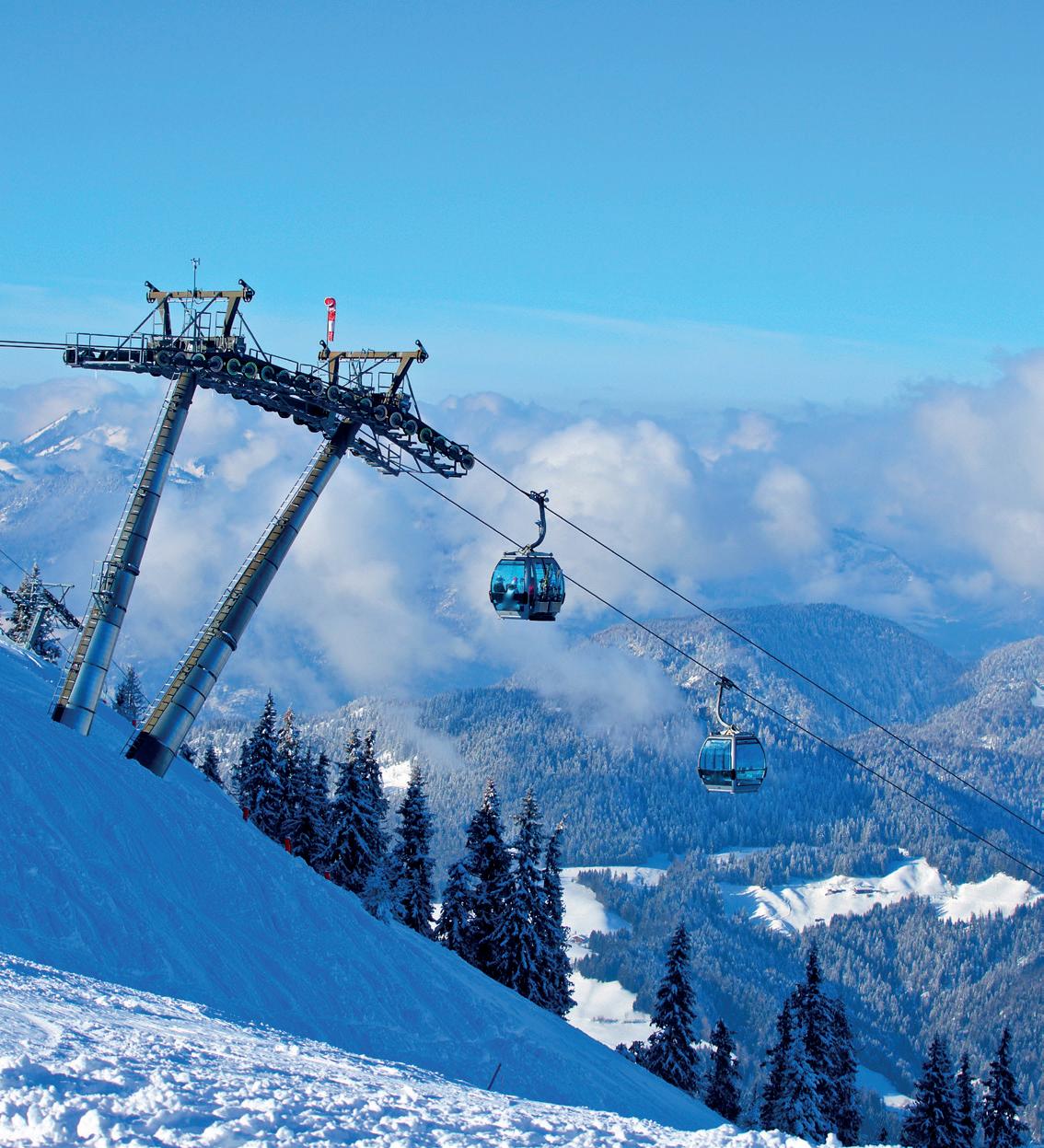
PYHÄ, FINLAND
Heading further north, Pyhä Ski Resort in Finland has the ambitious aim of becoming the world’s cleanest ski destination. Situated in Lapland, the area already benefits from some of the cleanest air on earth, but sadly it’s also on the frontline of the climate crisis, having experienced warming nearly three times faster than the global average. Pyhä is working hard to combat this trend. The resort initiated an environmental responsibility programme in 2008 which has led to an impressive 90% reduction in direct CO2 emissions, and since 2011 it has been carbon-neutral. The programme was expanded in 2019 to encompass environmental, social, and financial dimensions, most notably investing a remarkable 75% of profits into operational development. Finally, Pyhä has taken a ‘Scottish’ approach to their snowmaking. By flanking their pistes with fences, they are able to catch snow that would’ve otherwise been blown away and spread it across the runs, reducing the need for snow cannons.

“Pyhä has the ambitious aim of becoming the world’s cleanest ski destination”
CHAMONIX, FRANCE
As the Mer de Glace – the largest glacier in France – continues its rapid retreat above Chamonix, this legendary alpine town needs no further reminder of the urgent need for climate action. Indeed, the locals are determined to use their own experience as a lesson to the world, with a new 53 million euro gondola planned to take people from Montenvers to the foot of the Mer de Glace.
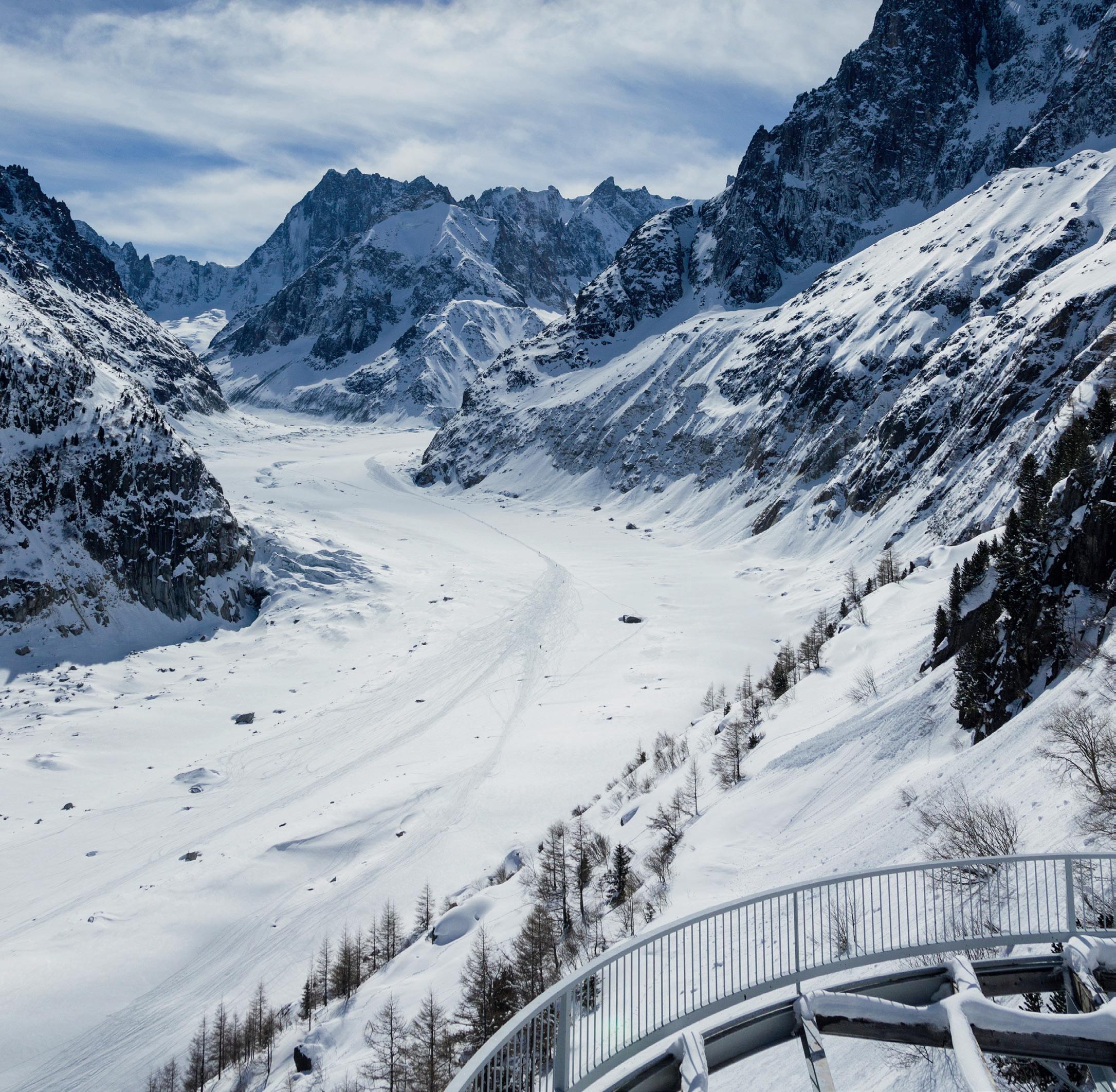
Here, they can witness first hand the speed and effects of global warming at a ‘Glacier and Climate Interpretation Centre’ – set to be complete by the end of 2023. In terms of day-to-day skiing operations, Chamonix has recently introduced an innovative climate and energy action plan that aims to reduce the carbon emissions of its piste bashers (the only part of the resort’s infrastructure that is still reliant on fossil fuels).
Public transport has also received welcome investment, helping to ferry skiers and snowboarders up and down previously hard-toaccess parts of the valley (we’re looking at you, Vallorcine). This commitment to sustainability has earned Chamonix the prestigious ‘Flocon Vert’ (Green Snowflake), an award designed to shine a light on mountain destinations that are doing their best in the fight against climate change.
SAAS-FEE, SWITZERLAND
Surrounded by some of the biggest and meanest 4,000 metre peaks in the Alps, Saas-Fee also stands taller than its peers as the first resort to achieve full carbon neutrality. This is thanks in part to its longstanding ban on cars at village level (a policy implemented way back in 1951), relying instead on buses and electric taxis. The resort is also powered by a hydro electric plant, while particle filters have been fitted to all chimneys in an effort to trap any nasty chemicals

released from wood-burning heaters. The town’s eco-consciousness hasn’t gone unnoticed, either. Winner of the gold ‘Energy City’ label in 2021, SaasFee has set a benchmark for all other ski resorts. This prestigious European award goes to municipalities that develop a sustainable energy policy, and requires recipients to complete 75% of their measures before receiving certification – including disposal of rubbish, climate education, green buildings and eco-friendly mobility.

SCOTTISH RESORTS
While their efforts at solar power or traffic-reduction might not match those of the continental resorts above, we couldn’t tackle the subject of ecofriendly skiing without mentioning the fantastic resorts we have available on our own doorstep. With rail and public transport access – and certainly no need to fly – a ski trip within the British Isles is a great way to get your winter fix while minimising your carbon footprint. The five Highland resorts of Glencoe, Glenshee, Cairngorm Mountain, Nevis Range and The Lecht are all worthy of a visit. One of them (Nevis Range) receives the majority of its power from hydro and achieved Carbon Neutral Status in 2021; it is now targeting zero waste. Keep an open mind, an adaptable plan and an optimistic outlook on an otherwise ‘iffy’ weather forecast, and Scotland can provide some truly epic conditions without crossing the Channel.
“A ski trip within the British Isles is a great way to get your winter fix”
THE NEW SEASON’S
SKI CLOTHING


ON LOCATION IN CRANS MONTANA


Picture Men’s Object Jacket £299
Picture Men’s Object Pants £219








Goldbergh Women’s Premier Zip Neck £169



Goldbergh Women’s Pippa Stretch Pants £459
Goldbergh Women’s Porter Jacket £529






















 The North Face
The North Face







 The North Face Men’s Fourbarrel Jacket £359
The North Face Men’s Fourbarrel Jacket £359
CARVE A PATH PISTE
SKIS & BOOTS
SALOMON MEN’S ADDIKT PRO + Z12 GW
£780



The edgy design of the Addikt Pro highlights exactly what it’s best at: ripping groomers all day long. Boasting super-fast edge-to-edge response thanks to its tiny 66mm waist, race-derived Blade Technology, and a wood and Titanal core, this is a seriously high tech carving ski that will eat corduroy for breakfast.


HEAD WOMEN’S REAL JOY + JOY 9 GW SLR
£520

A versatile, confidencebuilding piste ski, the women’s Head Real Joy offers lightness, agility and unrivalled balance that will flatter your technique no matter what your starting level. The EMC dampening and Graphene layer make cruising down blue or red runs an effortless pleasure. All in all, it’s an easy-to-use ski that deals smoothly with piste and trails alike.
ATOMIC WOMEN’S CLOUD C11 REVOSHOCK LIGHT + M 10 GW £600

The Atomic Cloud C11 Revoshock Light brings calm to choppy conditions, as well as smooth performance on perfect morning corduroy. The confidenceinspiring edge control is augmented by excellent shock absorption via its Revoshock Light feature and a TI Powered laminate construction. Clean looks and a Light Woodcore complete an effortless ride.
SALOMON WOMEN’S S/PRO SUPRA BOA 95 GW £430


Salomon have taken what would have been a classic four-clip boot and spliced it with the BOA system to give superior foot hold for medium volume feet. The BOA system is easily tightened or loosened with a tweak of the dial, and ensures that uncomfortable hotspots are consigned to history. Salomon’s Custom Shell technology and My CustomFit 4D Sport round out the offering.
NORDICA WOMEN’S HF 85 GW £430







If you’re in the market for a hands-free, low hassle boot then this should be in the running. The rear entry and Back Buckle Closure System make getting in and out simplicity itself. During a long day on the hill, comfort is assured thanks to the top-quality HF 3D Cork Fit W PrimaLoft liner, PrimaLoft insulation and Nordica’s signature Infrared technology that personalises the fit.




HEAD MEN’S EDGE 110 HV GW £370












Designed for intermediate to loweradvanced skiers with wider feet, the Edge 110 HV GW focuses on convenience and comfort. The latter comes via the Perfect Fit 3D customisation-ready Evo liner and EZ-ON construction, while the former is taken care of by the EZ-Walk Switch and GripWalk soles that allow for an easy transition from skiing on the slopes to walking in the resort.

FREE THINKING


ALL MOUNTAIN SKIS & BOOTS
K2 MEN’S RECON 120 BOA GW £550
Lightweight but still offering considerable control and precision, the K2 Recon 120 BOA features the BOA closure system on the forefoot area, which allows precise adjustment to suit the conditions. Performance elsewhere is assured due to the Powerlite Shell, which combines four different stiffnesses of TPU to reduce weight and enhance response.

FISCHER WOMEN’S RC4 105 MV BOA VAC GW














£570
With true race heritage, this performance-orientated boot from the experts at Fischer offers excellent customisation and a punchy 105 flex, augmented by the addition of the BOA closure system. The intensely mouldable Vacuplast plastic shell and RC MV Performance liner combine to ensure comfort and warmth, without compromising on control.







DPS MEN’S KAIZEN 100 £1,250



Billed as a true all-mountain offering, the Kaizen 100 is unashamedly premium. Featuring aero-grade carbon fibre and an innovative Split Core, together with substantial rocker and a 15m turn radius, the Kaizen performs at the very top of the class. It’s a smooth ride that’s comfortingly stable but also manoeuvrable in all situations.
NORDICA MEN’S STEADFAST 85 DC + TPX 12 DT £625













The headline technology of the Steadfast 85 is Nordica’s Double Core, which cleverly combines Titanal and elastomer layers between wooden cores for an incredibly smooth yet powerful ride. This is married up with the Ti laminate and tip rocker to give precision and control just where you need it.
ATOMIC MEN’S HAWX PRIME XTD 120 GW
£560
The Atomic Hawx Prime XTD 120 GW is all about light weight, but without sacrificing performance. It operates in the space where all-mountain meets freeride, with Prolite construction that keeps weight down while retaining thicker, stiffer material where you need it. Elsewhere, the Free/Lock 4.5 hike and ski system provides 54 degrees of motion for skinning up, but still delivers precision for the run down.



SALOMON WOMEN’S STANCE 84 + M 11 GW £570
A smooth cruiser that will soak up all conditions with aplomb, the women’s Stance 84 offers high-speed stability on and off the piste. Its construction prioritises durability as well as energy and grip in firmer snow, and will keep advanced skiers happy and secure whatever the mountain throws at you.
THE FACES OF THE VALAIS



Locals share the secrets of their home resorts
 SKI TRAVEL
SKI TRAVEL
You know the old travel cliché: if you want to know where to visit, buy a guidebook; if you want to know what’s worth visiting, ask a local. Well, we believe the same applies to skiing, only more so. Think about it: even the best-drawn piste maps struggle to show how mountains fit together, and they often miss out valleys where the best powder is to be found altogether. TripAdvisor restaurant guides can’t really be trusted, and as useful as they are, Google Maps’ knife and fork symbols can’t ever capture a café’s vibe, or tell you if there’s a cool band playing in a particular bar. With that in mind, when we set about compiling a guide to Switzerland’s Valais region, we thought we’d go straight to the source. We asked four locals, from a variety of different backgrounds, to tell us what they love most about four of the region’s most storied resorts.
MAX PRATER, SAAS-FEE



Max Prater, a ski instructor at the Zenit School in Saas-Fee, first learned to ski on Christchurch dry slope, near his native Bournemouth. But like many Brits who catch the bug early, it wasn’t long before he was heading out to the mountains to do seasons and perfect his turns on real snow. Having gained his instructor qualifications, he worked in Europe and North America, before finally deciding to settle in the Valais, where he fell in love with the high altitude mecca of Saas-Fee.
What’s the best thing about living in Saas-Fee?

The main thing I like about it is just how good the skiing is. I did several seasons elsewhere and I wasn’t getting [many] great snow years. But then I came here, and the snow’s good from start to finish. It comes down to the aspect of the mountain. We’re north facing here, so we get a little bit of protection from the sun and that keeps the snow consistently firm and good for skiing. Also, the village is at 1,800 metres, and our lifts take us up to 3,600 metres. You’ve got a huge vertical descent, one of the longest in Europe. On top of that, we’re surrounded by eighteen 4,000m-plus peaks. We’ve got the highest mountain that’s solely in Switzerland looking down on us, the Dom, which is 4,545m. So it’s pretty impressive just looking around. I’ve never skied anywhere like it.
What’s your favourite run?
My favourite run just to rip down – especially first thing in the morning when it’s freshly groomed – is red 17A. It comes off the glacier at 3,600m and offers endless turns top to bottom. It’s usually pretty quiet and you just feel like a hero on it.
Saas-Fee
In numbers
Ski area: 146km
Altitude range: 1,500m - 3,600m
Resort height: 1,800m
“IT’S IMPRESSIVE JUST LOOKING AROUND. I’VE NEVER SKIED ANYWHERE LIKE IT”
Where’s your favourite place for après?

I usually head to the Pit Stop. It’s just at the bottom of the park, so you can sit in the deck chairs and watch everybody attempting to do jumps – some people better than others! [laughs] It’s always good music, good beer, and a good time.
Where’s the first place you go on a powder day?
I can’t tell you where I’m going, I’m afraid. [laughs]
Where’s best to go when the weather’s bad?
The best trees are around Plattjen. They’re nicely gladed and super steep top to bottom. They’ve usually been quite sheltered from the wind as well, so the snow stays good.
Where do you go when it’s totally tracked out?
It’s still kind of a secret, but I’ll let you in. You can drop off the back of the resort towards a reservoir called Mattmark. That’s a really cool run. It’s about 15 kilometres all the way down to the next village. You can ride it right down to a bus stop and get the bus back up to Saas-Fee. It’s all south facing, so it gets nice sunshine, and good snow. It’s pretty unique.
Where’s your favourite place to eat?
My favourite mountain restaurant is Spielboden. It’s a really nice little sun trap. I can highly recommend the pulled pork burger.
DAVID KESTENS, ALETSCH ARENA
Originally from Belgium, David Kestens swapped the lowland plains of his home country for the mountains of Spain and New Zealand before eventually settling in the ultimate mountain destination: the Valais. Attracted by the security, the peace, and his Swiss neighbours’ innate love for nature, he found his dream job working for the Aletsch Arena, the ski area which encompasses the villages of Riederalp, Bettmeralp and Fiescheralp.
What do you love the most about mountain life?
The whole quality of life in Switzerland is quite exceptional. What I love the most is that you’re in the middle of [so much] incredible nature. If you’re into sports, which I obviously am, it’s like stepping into paradise right out of your front door.
Why did you fall in love with Aletsch Arena?




The atmosphere here is incredible, it’s a car-free resort, and it’s high, so there’s guaranteed snow in the winter time. It’s very relaxed, not the stressy life of cities. And then you add the great Aletsch glacier, [which

Ski area: 104km
Altitude range: 1,895m - 2,869m
Resort height: 1,925m
in the Alps, it’s like a quiet thing in the background the whole time. Any time you get a view over that big giant, it’s just like, ‘wow’. Then, actually you can turn your head and see the Matterhorn in the distance. The views here are just superb.
What’s your favourite run in resort?
Being from Belgium, I’m not a professional skier, so I love our wide, blue slopes. They’re perfect for cruising and carving, and actually it’s never that crowded.



Where’s your favourite place for a coffee?
The Café Imhof in the middle of town is spectacular. There’s a beautiful view of the church and the Matterhorn. The whole town is ski in, ski out too, so you can catch a lift and ski right up to the terrace, which gets the sun from morning til evening.
What’s your favourite mountain restaurant?
There are lots of great options, but the Chüestall is one of them, and it has a very interesting speciality called ‘Cholera’. It’s a vegetable pastry dish which dates back to 1836, when there was an epidemic of the disease. Locals baked whatever food they had in the house into pastries, because they were too scared to go outside. It’s actually very tasty though!
AMANDUS AMACKER, NENDAZ
Amandus Amacker, the longest-serving ski instructor at the Ecole Suisse de Ski in Nendaz, is universally known as ‘Ami’ – because he’s everyone’s best friend. Originally from the German-speaking part of the Valais, he moved to Nendaz more than four decades ago, and now lives there with his wife and grown-up son, a professional skier.

When was the first time you visited Nendaz?


I first came here in 1975 – a very long time ago, when I was young. I was working building houses but my dream was to teach skiing. I looked around and said: ‘Okay, here’s a nice place, maybe next winter I try to come back.’ So in 1976, I came back and they accepted me on the instructor course.
It was very different then. When I started, there were just 17 ski teachers in the Ecole Suisse de Ski here, and after 10 years that had grown to 40 or 45. And then in the early 80s they connected everything with Verbier and the other resorts [Bruson, La Tzoumaz, Nendaz, Veysonnaz and Thyon] to create the 4 Vallées.
What is it you love the most about it here?
The people in Nendaz are very spontaneous. They’re very open and welcoming. I also like the way you have
Nendaz
In numbers
Ski area: 410km
Altitude range: 1,371m - 3,300m
Resort height: 1,400m
people coming from all over the world, all these different cultures. I get to teach people from all over Europe and America – that’s just fantastic. And naturally, the ski area is the greatest.
What makes it so great?
Well, I am a little bit of – how do you call it – a patriot? [laughs] So I think it’s the best in Switzerland. There are of course others that are good. But I live here and for me it’s the best because I know it so well. So when the weather is good I go perhaps to one side, or when it’s bad, I change and go to the other…
Where’s the best place for powder skiing?
Plan-de-Fou / Prarion is a really good freeride area. It’s special because it’s a bowl, the slope curves round. So you start in the morning on one side, and then you turn a bit when the sun moves and go around to where there’s better snow. But lots of Nendaz is good for freeriding because we have a lot of north-facing slopes where the snow will stay cold and softer for longer.
Where’s best when the weather’s bad?
I think the Alpage piste – because you are among the trees, so the visibility is much better. It’s really hard to ski when you can’t see anything [laughs] but on a tree run like the Alpage piste you can see even when the [weather] is bad.

Where’s your favourite place for après ski?

I often stop [at the] Edelweiss at the end of the day. In the high season, there’s often live music. It’s [got] a very good ambience with lots of different people from all over the world.
What’s your pick of places to eat?
My favourite place for lunch is the Combatseline. My friend is the boss there, the food is always varied and it’s really good. And don’t forget the panache – it’s something special.
LARA BERRA, RÉGION DENTS DU MIDI
There was never any doubt that Lara Berra would grow up to be a brilliant skier. Born into skiing royalty (her father Christophe was on the Swiss national team and her sister Camillia represented the country in slopestyle at the 2014 Sochi Olympics) she grew up in the town of Champèry in the Région Dents du Midi, part of the vast Portes du Soleil ski area. Like her sister, Lara travelled a lot in her 20s. She eventually returned to Champèry to settle and took over the running of the family business, the Hotel Suisse.
What are your earliest memories of Champèry?

My first memories are basically just being outside all the time. No matter the weather, my parents

would take us out skiing, biking, hiking or whatever. And it’s a safe place, so when you’re old enough you can do these things by yourself, and walk everywhere. It’s great.

What do you most appreciate about the place?
I really like that lots of people who live here don’t work in tourism. We’re really close to Geneva, and Lausanne, so people can live here and work there. It means that it feels more like a real place, not just a tourist village, you know? At the same time, we have guests coming from all over the world and access to this huge ski area. It’s like a win-win.
What’s it like to work with your family?
We’re lucky because we’re really close. My sister is my best friend – we tell each other everything all the time. She’s always been the competitive one, though. Obviously when she started doing slopestyle and hitting the jumps we were like, ‘oh just be careful, please!’ We were a bit scared. But of course, she ended up in the Olympics, and we’re just so proud of her.
Are there any downsides to it?
Just that out of me and my sister, the two hotel directors, I’m the one who lives the closest to the hotel. So if something goes wrong, I’m usually the one who gets called first! [laughs]
What’s the best place for lunch on the hill?

My favourite restaurant on the Swiss side of Portes du Soleil is definitely Chez Coquoz. It’s a family-owned restaurant and they’ve been there for years and years. Their terrace is just amazing. You’re in the sun the whole day, protected from the wind, and the food is incredible. The menu is a mix between really fancy food, or just traditional Swiss stuff, which they do really well.
Where’s your favourite place for après?
There are two great choices. I like to stop at The Red, which is at the top of the main cable car. They have a really nice mix of music and a great ambience, and you get the best view [in the resort]. It’s a 360 degree view of the mountains. If it’s a bit less sunny, we come down here to Champèry, to Le Bar des Guides, which is more like a small pub. When it’s busy, it can be elbow to elbow, really crowded, with a great atmosphere. It’s actually the bar attached to our hotel; I don’t know if I should promote our own bar, but it genuinely is the place where all the locals go –and it’s really good fun.
Where do you get your coffee?
I would head to Le Gueullhi, which is the small café by the base of the cable car. That’s where everyone meets, and if you don’t have a skiing buddy for the day, you’ll always find someone to ride with there.

Région Dents du Midi In numbers

Ski area: 650km
Altitude range:
930m - 2,277m
Resort height: 1,050m
WHERE TO STAY
Saas-Fee
The three-star Hotel Feehof is conveniently located in the centre of the resort. It’s a sunny spot with easy access to the ski school, shops and lifts. feehof.ch
Aletsch
The brilliant Waldhaus Bettmeralp Hotel serves amazing traditional food, craft beer and local wines in a relaxed atmosphere. There’s a record player and a fantastic vinyl collection in the lounge. waldhausbettmeralp.ch
Nendaz
The new Mad Mount Hotel combines minimalist, modern interiors with a welcoming bar and excellent spa facilities to help you unwind after a long day on the hill. madmount.ch
Région Dents du Midi
The Hotel Suisse in Champèry, run by Lara and her sister Camillia, combines traditional Swiss charm with modern standards of service. The Bar des Guides right next door is one of the most popular local drinking holes. hotelsuissechampery.ch
To find our more about the Valais go to valais.ch
Louise Pode is an Executive Coach and NLP Master Practitioner with over 25 years’ experience. She works extensively in the Alps with New Generation Ski School and runs personalised programmes both online and in resort.


SKI SKILLS
THE MENTAL GAME: HOW TO BUILD YOUR SKIING CONFIDENCE



Many of us are nervous skiers. Confidence coach Louise Pode shares her tips for changing your mountain mindset.
The skiing holiday is booked and the family can’t wait, but as the departure date gets nearer that inner dread starts to build. How can they be so excited, yet you feel so anxious?
If this sounds familiar, you are not alone. Anxiety on the slopes is more common than you might think. It creates a plethora of negative emotions – including isolation, humiliation and fear – for literally thousands of skiers. I should know; I was one of them.
In December 2016, I was on a Christmas skiing holiday in Val d’Isère. The children had been excited for months and I was putting on a brave face. On day four, I found myself at the top of Le Face – committed. I looked down at the steep, icy expanse; heart racing, a feeling of deep dread in the pit of my stomach, rigid with fear. Voices of encouragement floated across from the group: “You can do this”, “You’ll be fine”, “Follow me down…” I urged them all to go on ahead in an effort to take away that feeling of pressure, of being the focus of attention. Finally, I set off gingerly and lurched into a turn, leaning back, out of control…. down I went. Tears of frustration began to flow: “I can’t do this… I knew this would happen.”
Fast forward to Christmas 2023, and we are staying in the neighbouring resort of Tignes. Once again, I find myself committed to Le Face. It’s just as steep, icy and intimidating as before, and as I perch on an icy mogul –with crusty off-piste in front of me – a feeling of déjà vu sets in. This is really going to test my skiing strategies.
I take a moment, and look up at the stunning view. “Wow…” Deep breath… I can feel the cool mountain air. “I’ve got this,” I tell myself. “I love my skiing.” My mind is clearing and I’m making a plan. I slide down into the middle of the run where there is a smattering of snow and look around at how other skiers are managing – there’s someone coming down cautiously; she’s got a good line. I step in and follow, focusing on her turns, and before I know it, I’m out of the worst of it and on my way. Reaching the bottom I feel elated: “I’ve conquered the world!” Finally, that run is no longer my skiing nemesis.
The difference between these two experiences is not about technique – I’d had plenty of lessons and knew how to ski. It is testament instead to the power of the mind.
Let me share what I wish I had known in 2016 to create that shift from anxiety to liberation.






Join us in London and Manchester this November for two confidence building evenings with Louise.
Find out more at ellis-brigham.com/events
Control the controllable
Plan ahead. The idea is to create an environment which will enable you to enjoy your skiing and build those positive experiences. Aim for a suitable resort with plenty of easier runs that will nurture your confidence, and ensure you have a ski buddy to explore the slopes with. Be open with the group about your ability level so that you don’t find yourself out of your depth.
Own your anxiety

Anxiety can be an important and even useful emotion, but understanding it is key. The symptoms I described above – heart racing, deep dread, feeling rigid – were my own physiological stress response. Take a moment to think about your own. When have you felt most anxious while skiing? What were the three key signs for you? And which one came first? Recognising the first symptom and understanding how it manifests will put you back in control. It enables you to use the following strategies to calm yourself before anxiety overwhelms you.

Calm your mind
When your mind runs away with anxiety, it’s like white noise that stops you from thinking logically. It is well recognised that slow, deep breathing techniques – such as box breathing – promotes a state of calm and reduces that strong physiological response, allowing you to think more clearly.
Switch your focus
When we’re stressed, we focus on everything that reinforces it, creating our own ‘reality of fear.’ It’s important to manage the inner voice that is doubting us and catastrophising. Be kind. Tell yourself, “it’s ok”, “you’re fine” or “you’ve got this covered”. Pull your focus away from any thoughts that build anxiety and focus on the things that calm you: stunning views; the coolness of the air; freedom from daily routine; the special experiences you are creating.
Make a plan
Rather than skiing with high stress levels, take control. Use your deep breathing at the top of the run, look up and focus on the beauty and clarity of the mountains. Observe other skiers – what can you learn from how they are skiing? Look at the line they are taking on the slope and make your own plan. Avoid stopping on the brow so that you’re looking down; instead, aim to turn across it to control your speed and give yourself continuity. If you feel yourself being overwhelmed, stop and reset – just because a run starts off badly, it doesn’t need to end that way.
Change your mindset
With a strong inner motivation and the right coaching, you can overcome those barriers which are holding you back. Imagine how proud and liberated you will feel to be able to look forward to all those future experiences with friends and family!
Find out more at proability.co.uk
SALOMON WOMEN’S ICON LT PRO HELMET PRICE: £130

The lightweight (360 gram) Icon LT Pro is fabricated from a polycarbonate outer fused to an EPS4D foam liner, the latter working like the crumple zone on a car in the event of a crash. Excellent airflow thanks to the adjustable active ventilation channels, a washable Advancedskin Activedry liner and easy adjustment complete the package.



HEAD START
SKIING ESSENTIALS
GIRO UNISEX NEO MIPS HELMET
PRICE: £140
A perennial bestseller, the Giro Neo MIPS helmet combines safety and convenience with style. A lightweight, polycarbonate outer shell is fused to an EPS foam liner with an essential Multi-directional Impact Protection System (MIPS). There’s also a controllable venting system and On-The-Fly vertical tuning that can be adjusted to accommodate different goggles and head shapes.





SMITH UNISEX BLAZER GOGGLES














PRICE: £90
Keenly priced and featuring top-notch lens technology, the Smith Blazer is a popular choice. A slim frame design and wide cylindrical Carbonic-x lens provide maximum field of view, while the anti-fog treatment and ventilation channels keep fog at bay, ensuring excellent clarity even when you’re working hard.








DRAGON WOMEN’S DX3 GOGGLES
PRICE: £70
A low-profile, wraparound fit gives the Dragon DX3 a fantastic field of view while not getting too bulky. Dragon’s LUMALENS technology increases clarity, the ionised finish reduces glare and the anti-fog and hydrophobic coatings work to keep your vision clear. Two lenses and a cleaning bag are included, plus the DX3 works with prescription eyewear.
THE NORTH FACE WOMEN’S NAMAK JACKET






PRICE: £235

Designed to shrug off whatever conditions you might find on the mountain, the Namak insulated jacket combines a waterproofbreathable DryVent outer with Heatseeker Eco insulation that provides excellent warmth without cumbersome bulk. Recycled materials and a non-PFC DWR treatment mean it’s kinder to the planet too.
THE NORTH FACE WOMEN’S SALLY PANTS







PRICE: £135

Guaranteed to keep you warm and dry on the mountain, the Sally Pants layer waterproof, breathable DryVent fabric and lightweight Heatseeker Eco insulation into an impressive package. Made from recycled materials and featuring easy-adjust waist tabs for a custom fit, these are perfect ski pants for all conditions.




THE NORTH FACE WOMEN’S MONTANA GLOVES
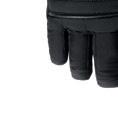
PRICE: £60

Something of a classic, the Montana glove is not only warm and waterproof (due to the Heatseeker Eco insulation and DryVent insert) but also boasts improved eco-credentials thanks to its recycled shell and liner fabrics and a nonPFC DWR finish. Etip functionality lets you operate a touchscreen with them on.






Dragon Unisex NFX MAG £210
Nothing if not top-end, the NFX MAG features Dragon’s Swiftlock magnetic lens changing system, which allows you to switch between the premium cylindrical double-layer lenses at will, depending on the conditions. A streamlined look is enhanced by the frameless design and an ionised hard coating on the main lens which cuts glare and repels water and oily fingerprints alike.
WINTER WONDERS MUST-HAVE SKIING ACCESSORIES

POW JJ £180

Lightweight and protective, the Fornix is a perfect blend of substance and style. A polycarbonate shell and impactabsorbing EPS liner is augmented with super-tech Aramid Bridges within the foam to provide extra rigidity. Active ventilation controls airflow, while a clip at the back keeps your goggles secure.





Barts Women’s Iska Beanie £33

No ski trip is complete without a choice piece of headwear for those chilly trips to the pub. The Iska is a fantastically warm beanie that features an attractive cable pattern and a pom, as well as an internal fleece headband that amps up the heat further and prevents itching. Made from space dyed yarn, each hat is unique thanks to variations in the process.
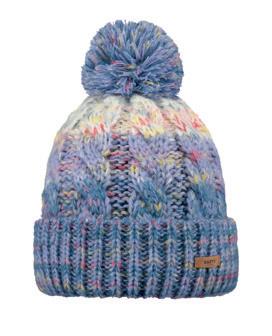
Therm-ic Unisex Powersocks Set











Heat Fusion Uni + S-Pack 1400 B
£270






The Therm-ic Powersocks keep your toes toasty in the coldest of conditions, thanks to a set of built-in elements woven in around the toe area. A set of slimline batteries last up to 16 hours, can be controlled with your smartphone via Bluetooth, and clip to the top of these comfy, performance fit socks.


Reusch Women’s Nuria RTX Mittens £120
Beautifully made and gloriously warm, the Nuria RTX mitten adds a touch of luxury even in the coldest climes, as well as offering excellent protection. A goat leather palm sees off wear and tear, while the down fill and RTX waterproof and breathable construction keeps the weather firmly at bay.





ellis-brigham.com



Ellis Brigham Team Wheelie Ski Bag £140





An understated essential, the Wheelie Ski Bag is designed to fit two sets of skis and poles along with accessories and other gear too, so you can keep check-in fees to a minimum. It’s also built to withstand the worst that luggage handlers can (literally!) throw at it, with durable wheels, heavy duty compression straps and a rubber pull handle.


Giro Women’s Terra MIPS £170



Sleek and stylish, the women’s specific Terra helmet offers a low-profile design with top-tier safety and convenience built in. The Polycarbonate shell is fused to an impact-absorbing EPS foam liner with MIPS, which reduces rotational forces in the event of a crash, while plush Max padding and ear pads wick moisture and are warm to the touch.
Hestra Men’s Army Leather GTX 3 Finger Mitts £165
The benefit of a three finger design is that you can enjoy the considerable warmth of a mitt with added dexterity. This robust goatskin leather design also features a GORE-TEX membrane for improved breathability and water-resistance – you even get a sachet of Hestra Care Balm included to keep the leather supple.





Barts Women’s Teddybuck Hat £47



In case you’ve been hiding under a rock, the 90s are back! This stylish bucket hat is constructed from fantastically soft faux teddy fur and is fully lined for extra comfort. It boasts a brim length of 5.5 cm and features an adjustable strap hidden inside to fit a wider range of head shapes and sizes.





Oakley Women’s Flight Deck M Mikaela Shiffrin £182



Inspired by the helmet visors of fighter pilots, the Flight Deck M goggle is designed for maximum field of vision. This collaboration with 6x World Cup Slalom Champion Mikaela Shiffrin uses her own design while retaining Oakley’s Prizm lens technology with Iridium coating and High Definition Optics (HDO). Top notch.

BURMA ROAD, AVIEMORE
Located just south of Aviemore, this area can occasionally harbour some incredible powder skiing with views across the Cairngorms. A small car park at the base provides ideal access while the track leading up towards the peak of Geal-charn Mòr allows for easy skinning. A variety of faces, angles and features offers fun for every ability.
LOCAL KNOWLEDGE
Scotland boasts some fantastic ski touring routes. Matt Brown from our Aviemore store shares a few of his favourites.


Name: Matt Brown
Job: Sales Associate


Main activities: Hill Running, Climbing and Skiing
Part of the EB family for: 1 year
‘THE ESCALATOR’ IN GLEN EINICH
This multi-discipline challenge is usually done in the second half of the season. Bike through Rothiemurchus Forest to the grand arena of Loch Einich, then hike and burn a line known as ‘The Escalator’ – sometimes even reaching the summit of Braeriach before skiing back down into Glen Einich. It’s a full day out but, if you’re willing to put the effort in, it provides smiles all around.


CAIRNGORM 4000S ROUND
The 22-mile ski ‘round’ takes in no fewer than five local munros. With highlights including the Cairngorm plateau, a ski down into the Lairig Ghru and a harsh skin up to Cairn Toul – as well as spectacular vistas – this day out has it all. Foul weather only adds an extra level of spiciness. It is often best during spring when the snow is well consolidated and the days are longer.
CREAG MEAGAIDH
The Creag Meagaidh National Nature Reserve holds some steep, fun lines set against a dramatic backdrop. Best tackled by experienced off-piste skiers, you can approach Coire Ardair by bike, where you can choose from several gullies depending on the snow. ‘Easy Gully’ (my favourite) is longer with some fun features. The steep and narrow ‘Raeburn’s Gully’ is another great option when conditions allow.
STEADFAST.
YOU’RE NEVER WRONG.
THE BIRTH OF A REVOLUTION
Our Double Core technology enhances a skier’s time on the mountain–no matter the terrain or conditions. So when we set out to create an entirely new ski rooted in versatility, we knew Double Core had to serve as its foundation. This led to the development of our Steadfast collection. On piste performance, all-mountain ability.
Ski: Steadfast 85 DC FDT









